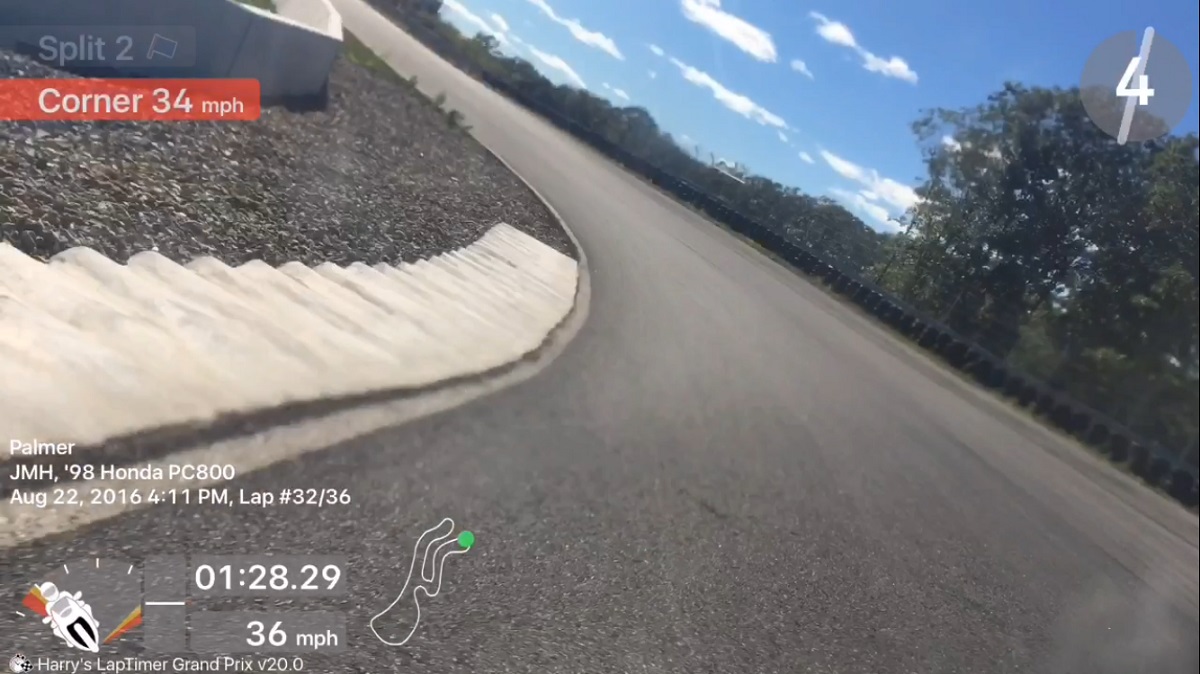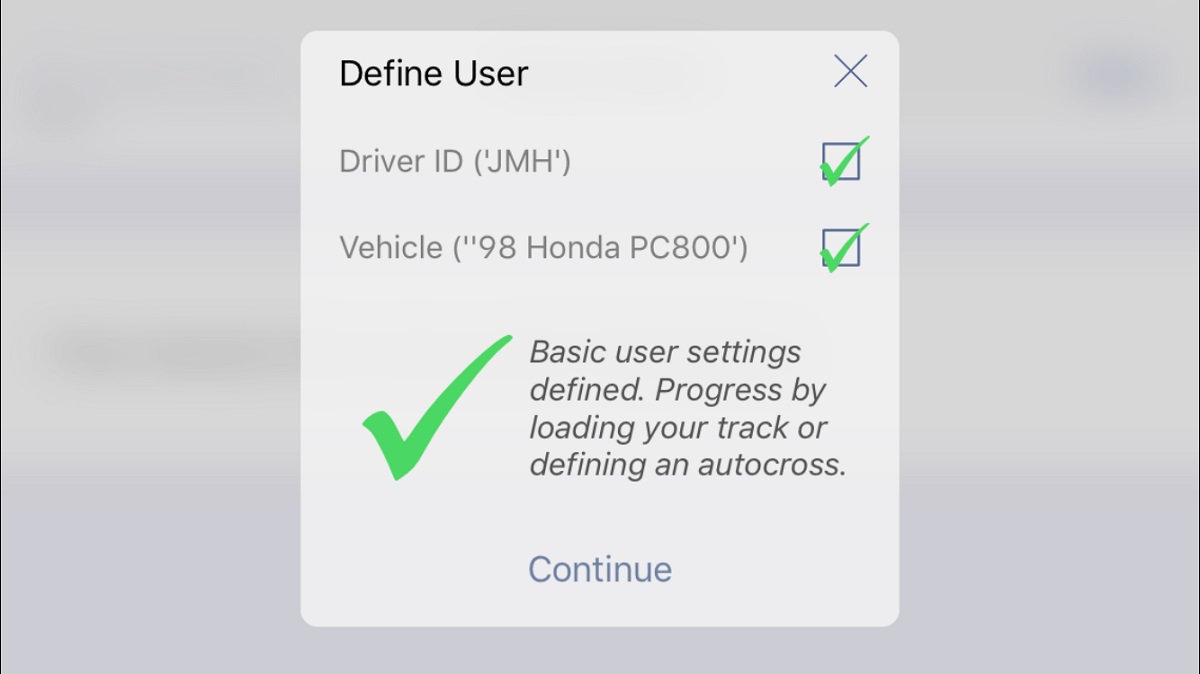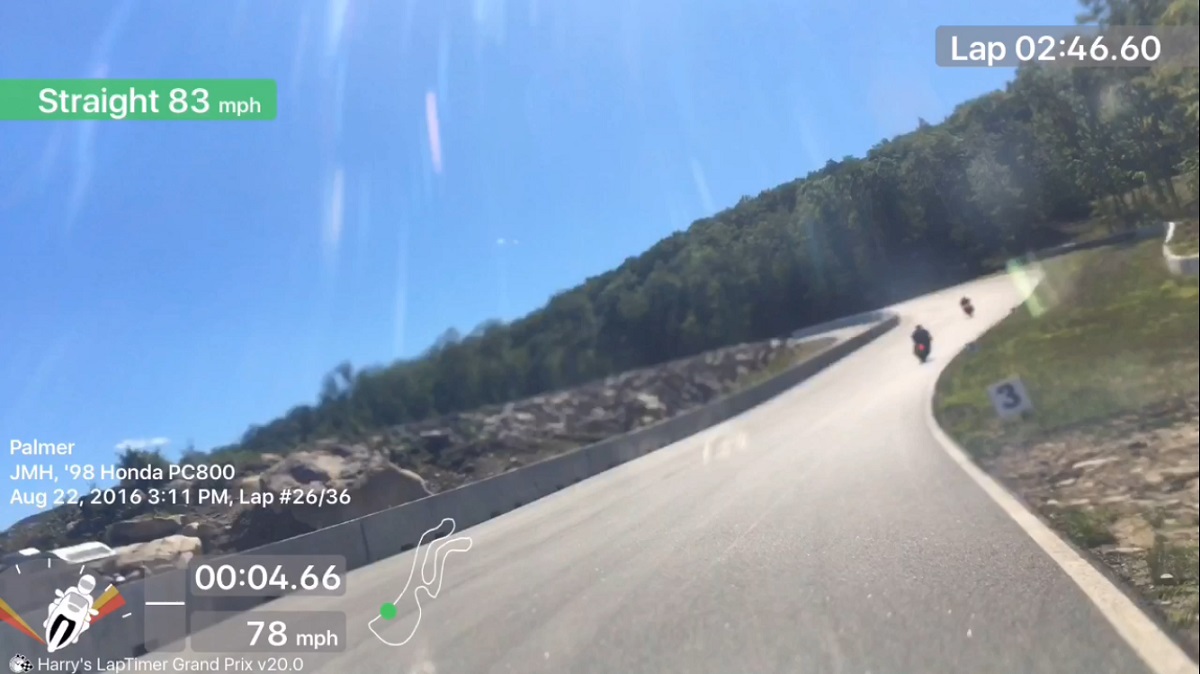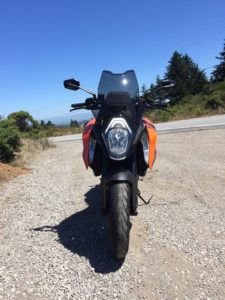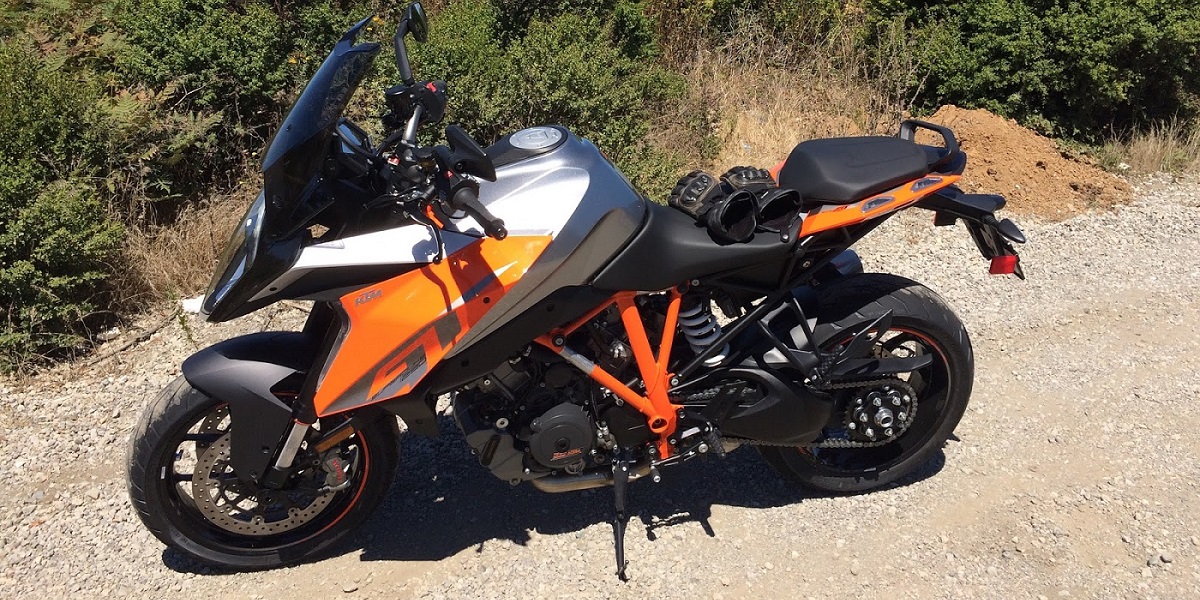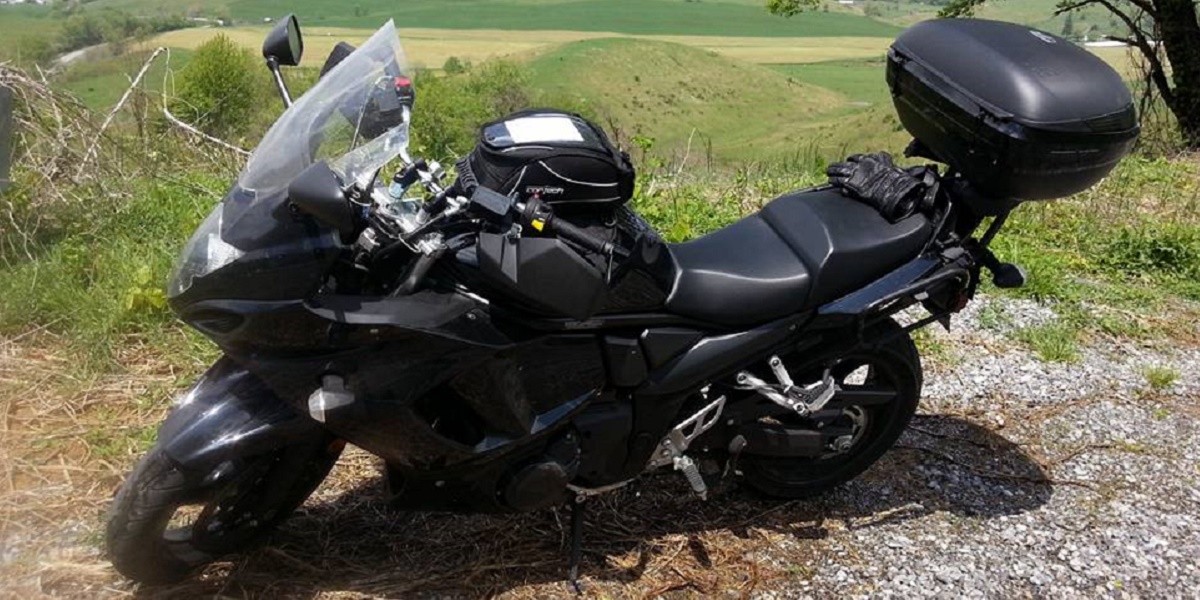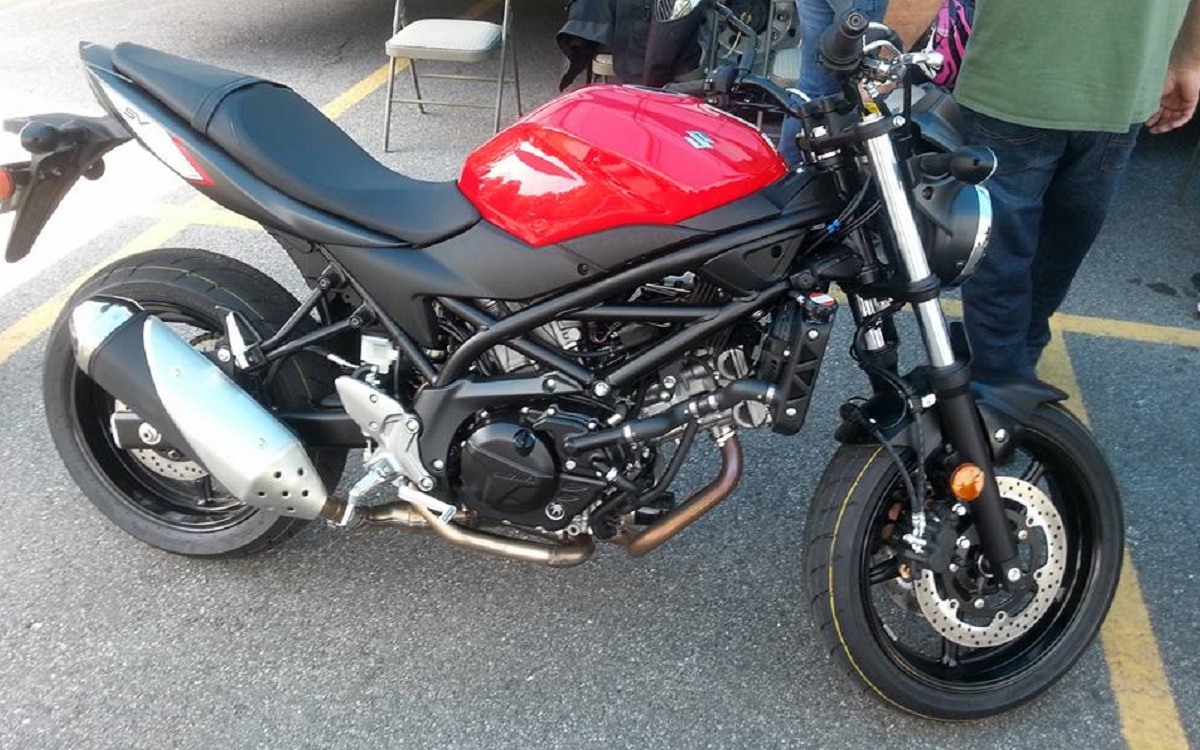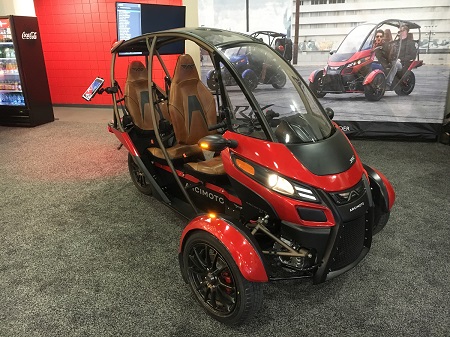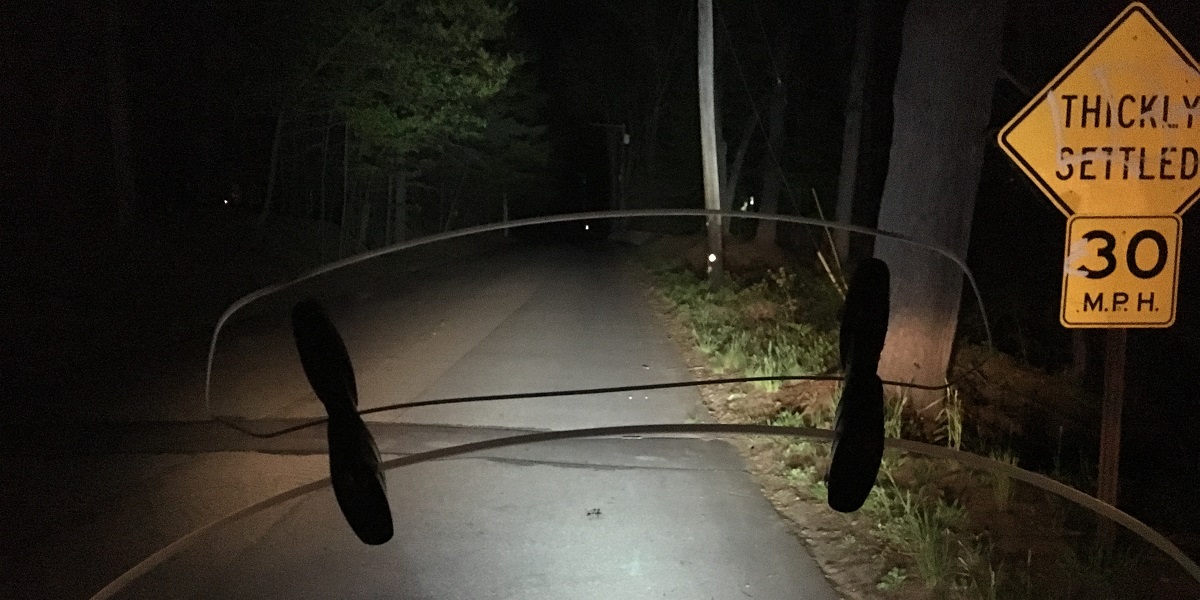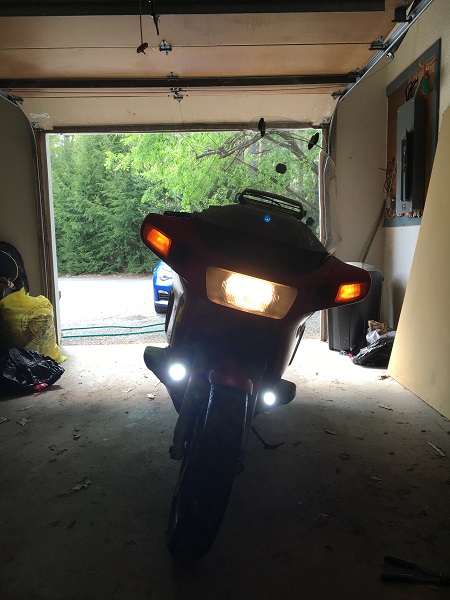Enter, 2009 Kawasaki Versys 650. Motorcycle #7 in my stable, and the fourth with a 650cc motor.
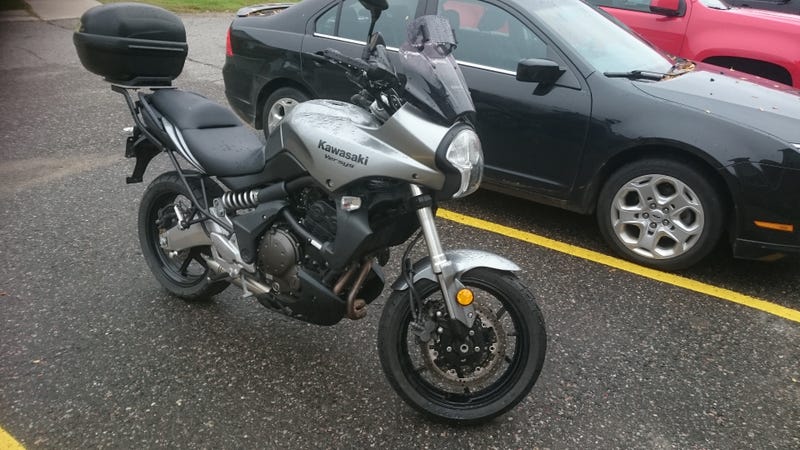
This particular example is shod in Shinko… something or other (I tend to call them crap) tires and has been lowered two inches (one inch in suspension, one inch from a foam-ectomy in the seat). A small wind deflector on the screen rounds out the modifications.
So, where do we start? Well, first impressions are that this is a 7/8s version of the BMW F800R that I have sitting at home. Seriously. Both bikes are parallel twins, 6 speed transmissions, both riding on 17 inch wheels, and both weigh in at roughly 440lbs wet.
Motor: This particular lump has seen a lot of duty in Kawasaki’s line up. Being used in the Ninja 650, the ER-6N, the Versys 650 and the Vulcan 650, it’s a cheap and cheerful motor, chucking about 65HP and 45ft-lbs at the rear tire through a chain. It’s not the world’s most exciting motor, and I personally dont like I-2s (I much prefer V-twins) but it does the job, and it does the job cheaply. I’m getting about 55mpg on the freeway at about 110km/h.
Brakes: I had to do a double take at these. These calipers look identical to the 16 year old units on my 2000 SV650! Truth be told, these Tokico calipers are used on just about every single “cheap” bike there is. And they aren’t THAT bad. The feel at the lever is a little wooden it must be said, but nothing a new set of pads and some new fluid wouldn’t help fix.
Suspension/Handling: Here, I’m a little annoyed. This thing has upside down forks… on such a cheap bike? Even my BMW didn’t come with UPDs until 2015. The previous owner was a shorter guy, so the whole thing sits an inch lower to the ground, with another inch taken out of the seat. This brings the seat height WAY down, and contributes to why I feel like this is a 7/8th scale F800R, and not an actual adventure bike.
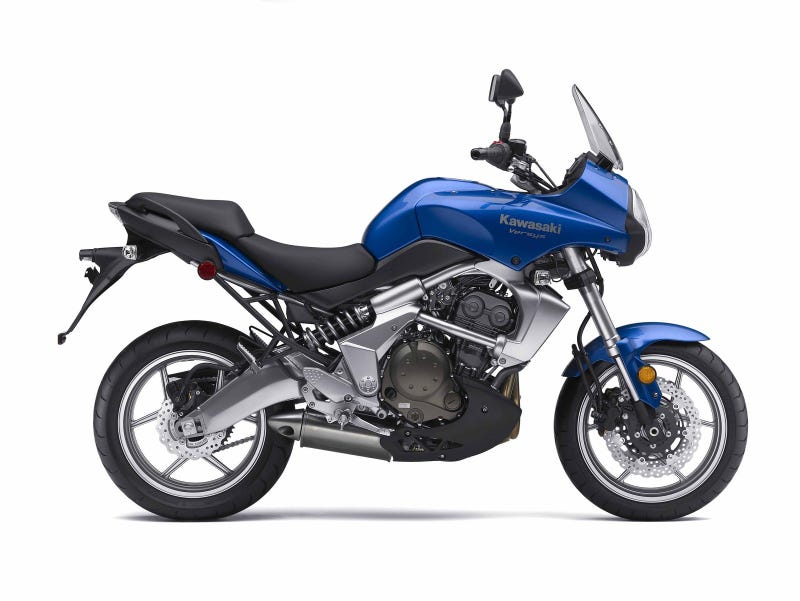
As far as handling is concerned, the bike is REALLY let down by those junk Shinko tires. The chassis feels light and nimble, and eager to turn in. But a rear with a flattened middle section (at least I know the previous owner did not rag on it hard) and just a shitty tire overall really really detracts from any athleticism this bike has. Once I get a set of Michelins or Dunlops spooned on this thing it should really wake up in that department.
And to answer everyone’s burning question, YES, this can be a good beginners bike.
I discovered this app by asking the same question myself after seeing some track videos with amazing telemetry. I used to do track days in cars regularly, and picked up the hobby again last year with my Subaru BRZ. I got some decent video with my GoPro, but especially since I’d be sharing my videos on our sister site Right Foot Down, I wanted to do something special. After upgrading to an iPhone 6s (an Android version is also available) with lots of memory, I splurged $27.99 for the Grand Prix Edition of Harry’s Lap Timer.
There are different versions available, for different prices with different features. The Rookie Edition is the most basic version for $8.99. It doesn’t support video, but it does give you access to all of the extensive telemetry features. That includes top speeds, corner speeds, lap times, split times, and all kinds of good stuff. The Petrolhead Edition will run you $19.99 and is where you gain video overlay capabilities. Basically the app simply records video at the same time as telemetry, and later gives you the option to mash the two together to make videos like the ones I made. The Grand Prix Edition is the big kahuna, enabling additional camera overlays. I intended to use my phone in my car for forward facing video, plus a GoPro on the back bumper for a picture-in-picture rear view. You can also overlay a reference lap on top of any lap to compare where you were faster and where you lost time.
At The Track
Obviously you’ll need to mount your phone quite securely to your bike, both to satisfy the technical inspectors and so that your precious phone doesn’t go skating down the track at 110mph. I use a Ram Mount X-Grip for my everyday riding, and it works great for that. I added a zip-tie to keep it shut and keep the phone attached to the bike on the track. I also plugged in external power, since the app drains the battery pretty quickly by using the GPS and camera constantly.
There is a little bit of configuration involved before you hit the track. First, you have to define the user (your name) and your vehicle information. You don’t have to fill out every last detail, but the more information you provide, the more accurate and interesting your telemetry and video will be. Once that’s done, you load the track where you are are running. Unless the track is brand new, there’s already a file containing GPS coordinates for all of the turns, the start/finish line, and other key locations. If you’re on a brand new track that isn’t listed, fear not – you can create it. Once that’s set, you’re ready to “race!” Even if you’re just lapping and not racing.
One of my least favorite parts about recording track video is that you generally have to manually start recording before you get on the track so that your attention is on driving/riding rather than fiddling with the camera. This problem is even worse when you’re wearing gloves and recording on your phone, which doesn’t react to the presses of your gloved fingers. You end up with several boring minutes of video showing people standing around the grid doing nothing before finally entering the track. But not with Harry’s Lap Timer! After you configure your session and tell it to “race,” it will go into a standby mode until you cross the start/finish line, then begin recording automatically. Ignore your phone. There’s no need to stab at your phone at triple digit speeds while riding – it’s got this. You will need to manually stop recording at the end of your session, but that’s OK – there’s no rush, and you can just trim the last minute or two off your video like I did.
Within the app, you can watch your video and telemetry overlay as soon as you’re done recording. If you’re racing or time trialing, this can give you immediate feedback as to where you can go a bit faster, or where you’re going a bit too fast and giving up some control. At Tony’s Track Days’ event, I had very little time between my track and classroom sessions, so I just recorded everything for later review. Well, almost everything – I chose not to record my first session, which was slow follow-the-leader laps to familiarize ourselves with the track. And something went wrong with my fourth session that made it not record properly. I’m not sure what, but my fifth and sixth sessions recorded perfectly, so it was probably a one time error. This was also my first time actually using the app at the track, so the error could well have been my own.
At Home
After the event, no doubt you’ll be wanting to show off to your friends – I mean, analyze your telemetry in detail to see where you can improve next time. While you can view the overlay video within the app immediately, to share it with the world you’ll need to render a new video containing it and save it to your phone. My full sessions, roughly 16 minutes of video, are about 3GB each, so you’ll want to make sure you have some decent memory available on your phone before recording or rendering video. Also make sure you have some time on your hands. My 128GB iPhone 6s is no slouch for processing power, but it did take several minutes for each video to render, as well as a big chunk of battery for the large amount of processing power required. Plug in your phone and make sure you won’t need to use it for a little while before starting this process.
The resulting video is then available just like any other video file. I used iMovie to add fades, titles, and crop the end of the video back to where I pit in. Then I had to render the video all over again. You can see how this can eat up a lot of memory after a while. After that, I switched to the YouTube app and uploaded each video from there. You’ll obviously want to be on a WiFi connection for that so you don’t blow through your monthly data allotment in one shot.
These are the first videos I have ever shot, edited, and uploaded entirely from my phone. Normally I download the raw footage to my laptop, edit it in Adobe Premiere Elements, and upload it from there. Basic video editing like this was actually easier to do on my phone. I find that amazing, considering that I actually went to college for video production and writing. My phone can do more than all the equipment in the TV studio could.
The Bottom Line
If you already have a smartphone with a good camera and a decent amount of memory, you’re 95% of the way there. For the average “track day bro,” I’d recommend the $19.99 Petrolhead Edition, which gives you video telemetry overlays without the more fancy features. But you can get as simple or fancy as you want to with Harry’s Lap Timer.
Best of all, now you, too, can have the entire internet asking you, “How did you get that telemetry overlay?”
]]>Speaking of sport touring, the bag setup is really sleek on the bike, and the big KTM looks great with them off the bike too. Two metal “pockets” on each side of the rear fairing are the only indication of the bags going on at all. No funny metal rack things to look less than ideal when you don’t have the bags on is a plus in my book. It’s also got comfy ergos for my 5′ 8″ frame with 32″ inseam, so touring is on the menu. Wind management is pretty good too. There’s plenty of air moving around at 75 mph, but nothing blowing your head off with the adjustable windscreen in the upper of its two settings. It’s much better than my Multistrada was stock for me, although it is pretty far from an R1200RT in the other direction.
Now the fun bit. It’s got the 1290 Super Duke R’s beloved engine and a big windscreen so you don’t get blown off the silly thing. Tuned for more torque??? Yep. TORQUE. Yep, all caps and I’m not retired, nor do I use AOL as my email provider. It’s big, plentiful, and makes this bike easy to scoot along in nearly any gear. Another design element I like is the tall top gear which allows the machine to loaf along at 4000 RPM at 70 mph. The engine mapping has three modes, but the sport mode is the one I want to explain as the other two are really good. Sport mode, though, is more and it’s fun! Rolling on hard feels like waking an angry demon and sounds similar with what seemed like more induction noise. The same roll on in other modes is fast but as fast (I think) and not nearly as loud and fun. It’s a power fiend’s fun mode. I suspect that using this full throttle a lot will reduce the range considerably like it does on my Multistrada. If you’re restrained, though, the 6 gallon tank and maybe 40 mpg will get you quite a ways down the road. I didn’t test the mileage but I know the tank is 23 liters.
There were some things I didn’t like. As a guy who has a bike that does everything really pretty well except go 5 mph, I was bummed that this machine doesn’t do that well either. Even at 9 mph in first gear the bike chugs and doesn’t like it. It’s not as unevenly fueled as my 2011 Multi at, say, 6 mph, but it isn’t happy. I was hoping for better but I do understand. It’s just not going to make you or a passenger happy if you do have to thread through standing traffic in San Francisco to get past a traffic issue. Not that this is ever fun, but if you try it on, say, an R1200RT, R1200GSW, SV650, F700GS it’s just soooo much easier and more relaxing.
There was also a noticeable amount of heat coming up onto the back of my thighs when stopped after the bike had been running for a bit. Not awful, as it wasn’t a hot day, but more than any other bike I’ve owned (I’ve skipped the Duc racetrack escapees). The bike also had a sort of high-frequency vibration when first applying from the brake. I only felt it in my hands. It might have been the surface of the brake disc or pad. Not sure, but it was like a stronger version of what I felt when I put a pretty aggressive semi-metallic pad on my R1200RT. It was an early demo bike so something might have been amiss there. The brakes worked great and had a pretty good feel. Not as good as an S1000RR or R, but very nice.
Overall I’m really impressed. You can read other articles or their website for all the details as there are many. It’s got traction control, ABS, cornering ABS and traction control, semi-active suspension, heated grips, cruise control, cool led cornering lights, a cool configurable dash (minus TFT color bling but I liked it), factory optional heated seats, slipper clutch, quick shifter, and probably other stuff I’ve forgotten. Add some firm but not silly suspension and the whole active thing and it’s so well behaved it seems downright reasonable to have a 173 hp motorcycle with 106 lb-ft of TORQUE. Good times if you have $20k for a stinking motorcycle! Maybe it represents a return to the days of yore when a VFR was a popular sport touring machine in all its mechanical glory? Or maybe it’s more Harley as the name is gosh darned mouthful.
]]>So my usual ride, heck, at this point my main mode of transport is a Suzuki GSX1250FA (Bandit) with a lovely 1250cc inline four that makes exactly enough torque. And by exactly I mean way more than I will ever, ever need. I can kit it out with touring stuff, and I can take it off and commute.
But like any good moto (or car, or guitar, or cat) enthusiast, I always want more. In my case, I want something more nimble than the Bandit. There’s a saying in the bike world that N+1 is the right amount of bikes, with N being the number you currently own. I own two but one is on its way out and I’d like to have something light and fun to toss around to replace my dying Katana, which is as close to a sport bike as I have.
Now with cars, you can just waltz into a dealership, and besides some funny looks for doing an outdated dance, you can just show your license and pretty much test drive anything within reason. With motorcycles, it doesn’t work that way. Usually if you are lucky, and SERIOUSLY looking to buy a bike, they might let you take it around the lot. So for us on two wheels it’s all about the Demo Days. These are days when either the dealership lines up a bunch of bikes to test ride, or a manufacturer arranges a whole bunch to ride. I never tried one until today and I really want to again now. I highly recommend waiting in line a whole bunch for an all too brief ride on something. Also, unlike amusement parks, this is free!
Also note, this demo day you rode in a group behind a leader bike. There’s a whole Reddit joke about leader bikes (look it up, seriously) but in this case it means a factory dude in a high-vis vest. They last about 20 minutes. Not enough to give you a total idea of a bike, but enough to make you want/or not want more. All you need is a motorcycle license (no permits) and long sleeves shirt, pants, boots. Heck you can even borrow a helmet but… ick.
Suzuki GSXR600
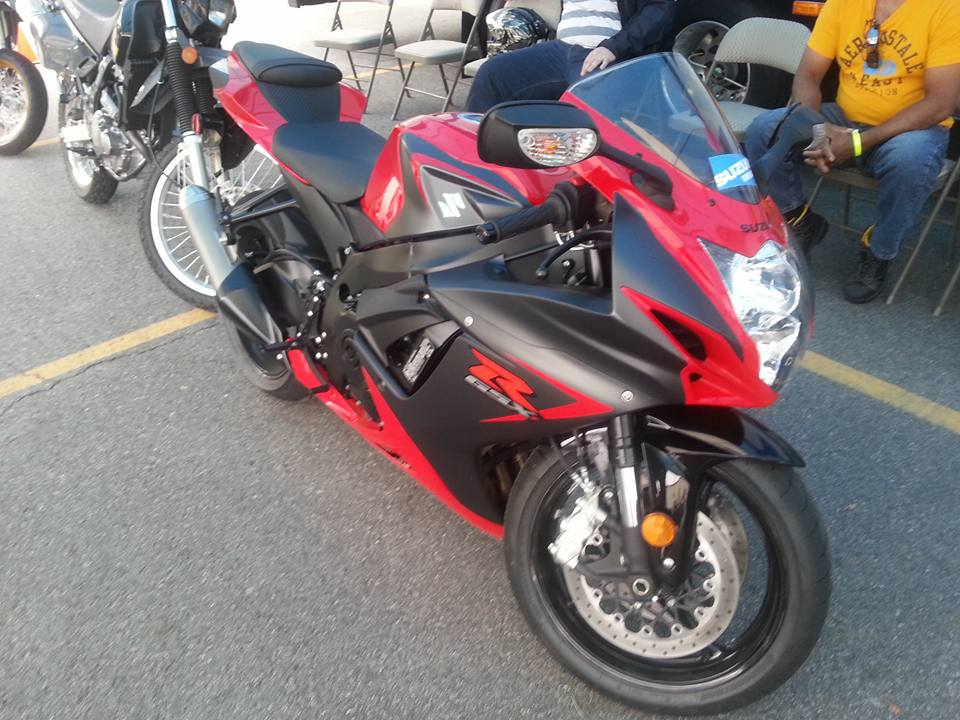
The Gixxer 600 is your entry level sport bike. It’s light, it’s nimble, you can flick it around and it has more than enough power to move you into stupid territory. It’s a great idea if you want to do track days, or be a squid, or just have something light and nimble to play with and go fast. Despite being leaned forward, it really is not at all uncomfortable. You sit forward but the bars are not as low as other sport bikes. I found the throttle to be very controllable, hell, easier than my Bandit. Never once was it jerky or surprising. It has plenty of usable power in the 3000-6000 rpm range for around town. I never got above 8000 on the city streets during the group ride, but I can only assume the fun begins above 10,000 since peak power is at around 13,000. I could easily see riding this around town, and then opening it up in second gear on an on-ramp and be doing over the limit before I hit third/merged into traffic. This is that kind of bike. I may sometimes be that kind of person. Not all the time, but definitely once in a while. It makes noise, but it would make better noise with a non-stock exhaust as most bikes do. It has a seat. I would not ride 200 miles on that seat, but I would easily commute my 50 miles each way on that seat. The brakes were nice and very linear. No surprises grabbing a little or a lot more of the brakes. Having never ridden a real “R” bike before I was intimidated before I rode it, but within a minute I was comfortable and at home. I feel like this is the sensible bike, for when you want to do non-sensible things.
Suzuki SV650
There is no other way around saying this: The Suzuki SV650 is the Mazda Miata of motorcycles.
It’s light, it’s fun, it can easily be at home on a track, it can be ridden daily, it’s relatively cheap, etc. etc. ad nauseam. Along with a Ninja 500, it is also one of the absolute most suggested beginner bikes.
And now I totally get all that and agree with it.
I’ve only sat on a Grom once and never ridden one, but just by sitting on it I wanted to do hooligan things on that tiny Grom. It just had that vibe and personality that makes you do that stupid grin that makes your friends nervous. From the moment I rolled away on the SV I got that smile. I’ve never wheelied, but I REALLY wanted to on the SV. It’s light. It’s upright. It sounds like the happiest little lawnmower in the world that just wants to GO! The redline comes up around 9K or so in an absolute moment. There’s not a ton of acceleration with that, but there a whole lot of GIMME-THE-NEXT-GEAR-LETS-DO-THAT-AGAIN!!! If you’ve never ridden before, you could hop on this and the noise would scare you well before the speed does (unlike most other stock bikes). If you’ve ridden before, you start going “WHEE!!!” inside your helmet. Which is far better than other bikes that make you do that in your pants.
I couldn’t believe how flickable the SV was for being an upright seating position. Usually I associate upright with “well this will take some effort to turn/lean” but nope. I felt like I could put the bike on the exact edge of the pavement on any turn (and I think I did) like I was Rossi or something. I’ve honestly never felt that way on a bike before. I could also bounce it in and out of potholes with abandon. It had brakes. They worked fine. The gearbox was surprisingly smooth for an entry Suzuki. The seat was actually less comfortable than the Gixxer which is kind of surprising but an easy fix. The only thing I didn’t like were the mirrors. I have no idea why Suzuki thought your elbows needed mirrors, but that’s where they are, and what they show. Again, a pretty minor aftermarket fix. All in all, I had a ton of fun on this bike. I get it. I totally get what people say about this bike and it’s true.
Which one would I buy?
Easy. For me it’s the GSXR600. If I bought either of these, it would be as a second bike. I want something fun and flickable, but I also like highway on ramps. As much shit-eating-grin fun as the SV was, I’m listening to the devil on my shoulder here. I could commute or do anything except my long distance stuff on the Gixxer. I also know how to keep bikes under 10,000 RPM, so for me, not a problem. I still feel like I’d have to go kind of Gixxer squid and get a pair of flip flops or something, though I would never wear let alone ride in them.
]]>You’ve also seen folks riding motorcycles without any gear and, depending on the state, without even a helmet.
Often the type of gear the rider wears rider is dictated by the crowd they fall in with as a baby biker: the “ATGATT” crowd do not let others in their ranks get away with anything less, and freely shame those in no gear. The gearless riders “live and let live” and do not shame others about protective gear, or mention at-fault accidents, or the potential for more protection. It is akin to religion: whatever you were brought up with, is your current belief system. Anything else is foreign, ridiculous, unthinkable.
Can a gearless rider be converted? And should “ATGATT” riders be preaching gear, or simply quietly setting an example, or shutting the hell up?
“I am worried about your eternal soul bodily integrity” doesn’t generally garner any warmth.
Can it be that riders who do not wear gear simply wholly accept road rash, blood, injuries as the inevitable outcome of any crash? Do gearless riders and their friends accept a different eventuality? Is it a given? Are they battle scars, war wounds? Of course you’re torn up; you crashed your motorcycle. Is it more dangerous, more risky, more thrilling this way? That’ll take months to heal, man. Good luck getting any sleep. Those bandages sure look uncomfortable.
The “ATGATT” crowd says: Do not accept this eventuality. Think harder about your well-being.
What a gearless rider accepts as inevitable, other riders take every precaution to prevent.
Some “ATGATT” zealots get tangibly angry upon hearing about a rider who has crashed their motorcycle and needed stitches, skin grafts; has a cracked skull or a broken jaw; posts pictures of several square feet of road rash, some of it right down to the bone, weeping blood and lymph fluid. No-one likes to see or even think about that. It is much easier to live in denial.
We have all encountered riders who insist they’re not going to crash. Of COURSE I don’t wear a full-face helmet. I don’t need one if I’m never going to crash. It is comforting to think we are safe. We have normalcy bias, an illusion of control, harbor too much optimism.
Mustn’t gearless riders think about the fact that the right gear for the conditions keeps a rider cool or warm as needed, protects (especially the eyes and hands) from road debris and bugs, keeps sunburn to a minimum, and, yes, will often keep a low-speed “oops” from being a trip-ending incident or a hospital stay?
Many “ATGATT” riders assume that riders who do not wear all the gear, are not serious riders, and this (forgive, as the data set is in the tens but vociferous) is because any small mishap – a stone tossed up from the road; an insect large enough, at 50mph, to break skin; a cloud of sand in the face obscuring vision for several vital seconds; a low-mph drop – can end that rider’s trip. Can a serious motorcyclist plan a multi-day tour without any insurance against the smallest injury? Can a serious motorcyclist truly accept that any small mishap will keep her off a bike for weeks to months while skin, muscle, bone heals?
And in these gearless circles, are there lessons to be learned? When a rider has an “unplanned getoff” do those who know and love that rider say, that could have been me? Is there any analysis of the preparation, and the outcome? What can I do to prevent those injuries should I ever fall off my motorcycle? How could that rider who crashed, and is now sporting bandages over road rash, or stitches, or worse, done better?
Motorcycle gear has advanced quite a lot in just the last few years: fitment, abrasion resistance, armor, adjustability, breathability, waterproofness have all improved. If you’re a gearless rider who hasn’t looked at motorcycle gear beyond a sweaty leather jacket in a couple of years, you owe it to yourself to try out a Cordura piece or two.
Have you seen the rider in a scuffed-up Aerostich and scratched-up helmet, roll into an event and regale the attendees with a story about his crash that same afternoon?
It’s something. Listen to him, after he’s had a few ibuprofen and a beer. He’ll tell anyone who is willing to listen exactly what happened, and maybe what he did wrong, just so someone else doesn’t make the same mistake – and he may also say, I was wearing all the gear, and I don’t even have a scratch. Better replace these gloves soon though.
]]>That skin, itself, is one of the most notable differences. While the Elio has an enclosed cockpit, the base model of the Arcimoto SRK is open. A roll cage surrounds you, as well as a windshield and a roof, but the sides are more open than a Jeep Wrangler with the doors removed. Body panels are available as an option, but don’t expect anything fancy, with the exception of the “Eagle Wing” door that opens up and over the roof like a simplified Tesla Model X. Each of the tandem seats has not one, but two three-point seat belts. Fastening both essentially straps you into a four point harness. Heated seats and controls are standard equipment, useful for those chilly mornings.

Another major difference is the controls. Both vehicles are legally considered motorcycles, since they have less than four wheels. But while the Elio drives like a car, Arcimoto uses motorcycle controls. The setup was quite familiar to me as a motorcyclist myself, but it employs an entirely different skill set than a traditional car, or the Elio. As a result, the SRK will not qualify for the “autocycle” category that Elio is pushing to allow people to drive their cars without a motorcycle license.
Arcimoto doesn’t seem to be concerned about this, though. They point out that you’re allowed to take your motorcycle license road test on whatever bike you bring, and therefore you’d be allowed to take it on an SRK. This would be the one, and only, instance in which I would NOT recommend taking the MSF Basic RiderCourse to get a motorcycle license, because almost nothing you’d learn about riding a two-wheeler would apply to the Arcimoto. You could also ride this on just a motorcycle learner’s permit as long as you follow its restrictions, which vary by state. While a learner’s permit for a car requires a passenger, a permit for a motorcycle typically prohibits one, so you could certainly teach yourself to ride it without much difficulty.
But the biggest difference between the Elio and the Arcimoto is the powertrain. The SRK utilizes two small but strong electric motors, each powering one of the front wheels. You sit on top of the battery, which stretches the length of the vehicle. Like a motorcycle there are two brake controls, but the foot pedal operates the mechanical brakes on all three wheels while the handlebar brake lever controls regenerative braking, which recharges the batteries. Arcimoto claims a range of 70 miles (130 with an extended range package), 0-60 in 7.5 seconds, and a top speed of 80mph. Given the SRK’s weight of a tick over 1,000lbs and the instant-on power delivery of electric motors, I believe these figures. And this is only 60% of the motors’ full potential. Arcimoto turned the power down to keep the SRK from burning up its tires like a front wheel drive Challenger Hellcat. I wonder how long it would be until the aftermarket develops a Tesla-like “insane mode” to unleash the SRK’s full potential, voiding every warranty and all regard for safety in the process.
So really, despite using the same general formula, the Elio and Arcimoto SRK are very different vehicles. In fact, the two companies don’t even consider each other to be competitors. While Elio has built a very small three-wheeled car, Arcimoto has created a Tuk-Tuk for the 21st century. I think this is wonderful, because Tuk-Tuks are awesome, as demonstrated by this video of the greatest Tuk-Tuk chase ever.
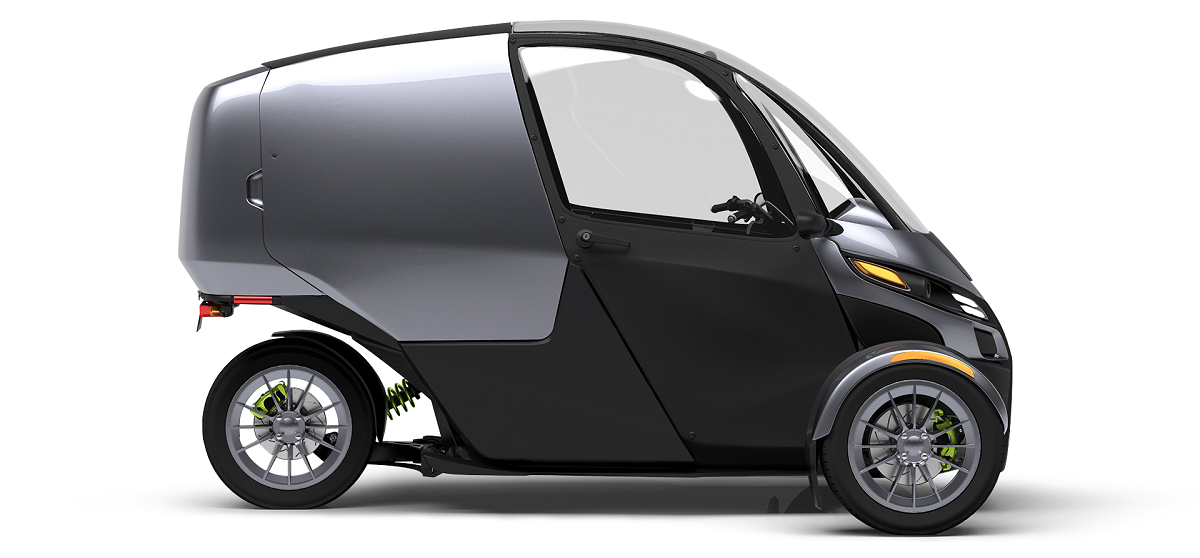
There is one more big difference between the Elio and the Arcimoto SRK. I’ve personally seen the SRK in action. While Elio is not yet allowing test drives of their prototype, I watched the SRK maneuver slowly through a roped off area of the Javits Center. While I absolutely believe that the Elio is fully capable of self propulsion as well, seeing is believing, and personally I think seeing the more radical SRK in action was even more impressive than seeing the more traditional Elio go for a drive. (That’s probably the first time the Elio has ever been called “traditional,” but with a gas motor and manual transmission, it is in this case.)
Arcimoto calls their three wheeled car bike thing “The Everyday Electric.” Though I’d need the extended range package for my daily commute, I could see myself taking this to work regularly. Despite being close to twice the price of an Elio, over time it would make up that difference in savings on gas. State and federal electric vehicle tax credits could also go a long way toward paying the premium over an Elio. I look forward to seeing what the future holds for both of these futuristic vehicles.
(To learn more about Arcimoto, check out The Untitled Car Show interview with Arcimoto’s Mark Frohnmayer and Jesse Fittipaldi.)
]]>I like this helmet. I don’t love it yet, but that’s where I’m going here. Helmet customization. Those of you who are Arai Signet loyalists know the first drill: back of a spoon to the forehead!
I can’t endorse purposefully compressing the hard foam inside your helmet. There’s that risk/reward scenario again — the more you compress the foam yourself the less compression it will offer your head in an accident. But without making a little more room for my oval skull the helmet was unwearable for more than 40 minutes. It didn’t take much compressing to make the helmet a comfortable fit.
The big problem I was having with this thing, though, is that I couldn’t breathe in it.
The chinbar on this helmet has a “chin curtain” which offers an excellent seal against wind, which means it fogs up my eyeglasses. Also, along my commute, in the sun, with the clear visor closed, I felt as though my face was in a greenhouse. I don’t like riding with the visor open, since I get sunburned very easily aaaaaand I don’t like bugs. The chin curtain holds onto the bugs that fly in through your open visor, until you can unlock the chinbar to evict them. Meanwhile they’re trying very hard to get out of there THROUGH YOUR FACE ooohkay no thanks.
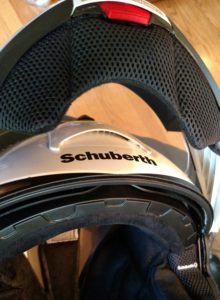
There’s no easy information available on the web about this thing. I can’t be the only one ready to cut it off the helmet, can I?
So I start to pull at it, and I find bolts buried behind the hard foam of the chinbar.

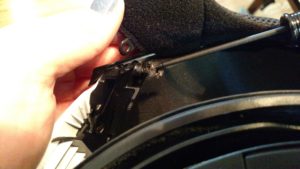
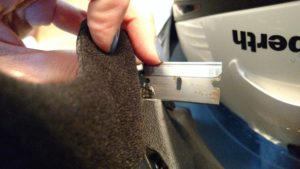

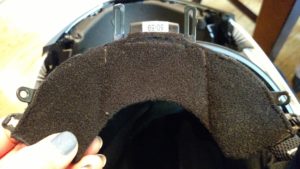
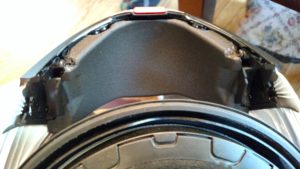
The helmet is only slightly modified (ahem) and the chinskirt can be reinstalled pretty easily. I put the bolts back in.
A ride with the newly-customized helmet shows it moves a LOT more air and doesn’t suffocate me at stops, isn’t noticeably louder, does not argue with my comm system’s boom mic nearly as much as it used to, the chinbar is easier to close, and now I can ride with the clear visor closed all the time without cooking my face or fogging up my glasses. Big win!
]]>I’ve ordered two Kermit Chair bags from him. They replace the bags the Kermit chairs come stuffed into, AND you can fit your leg extensions in there too — it really helps you keep track of all the parts of those stupid expensive chairs.
I recently went looking for tank panniers to fit on the AltRider crash bars on my Super Ténéré, and found a few expensive bags that didn’t quite fit. I contacted Brady, who had already worked out the dimensions of these things, and he made me a set of bags designed just for these crash bars. They’re a fantastic fit and super convenient!
 From Brady: Standard rectangular cordura liners for hard luggage are $35/each + shipping. Standard bags include: 1000 Denier material, carry handles, double pull YKK zippers, top or side opening. Other options are available as well for additional costs.
From Brady: Standard rectangular cordura liners for hard luggage are $35/each + shipping. Standard bags include: 1000 Denier material, carry handles, double pull YKK zippers, top or side opening. Other options are available as well for additional costs.
I have no connection to him other than being a happy customer; I highly recommend his work. Contact him directly at [email protected].
]]>
Having owned and used Sena’s SMH10 for bike-to-bike comms and piping music for several years, I loved it and was eyeing the camera version. About a year ago I received the 10C as a gift. I’d won a GoPro3 in a drawing a month before and, while the GoPro filmed my commute and other things easily enough, the 10C has a couple of huge advantages over the GoPro and other action cams: (a) it talks to you and (2) you can fiddle with your camera while on the move (maybe not the smartest thing, so keep your eyes open and don’t go poking at it in the technical twisties). The audio function lets you know just what it’s doing: “camera on,” “recording,” etc. as well as a shutter release noise for still shots.
The 10C mounts to a helmet as easily as any other Sena communicator – it includes speakers and a microphone (boom or wired, depending on your helmet design) and will take a reasonably patient person about an hour to fit the mount and all of the pieces, and tuck all the wires out of the way. The unit itself is unobtrusive (again, unlike a traditional shoebox-on-your-helmet action cam) and has two planes of adjustment: up/down and side-to-side swivel. A few tests of stills and short videos will make the needed adjustments evident.
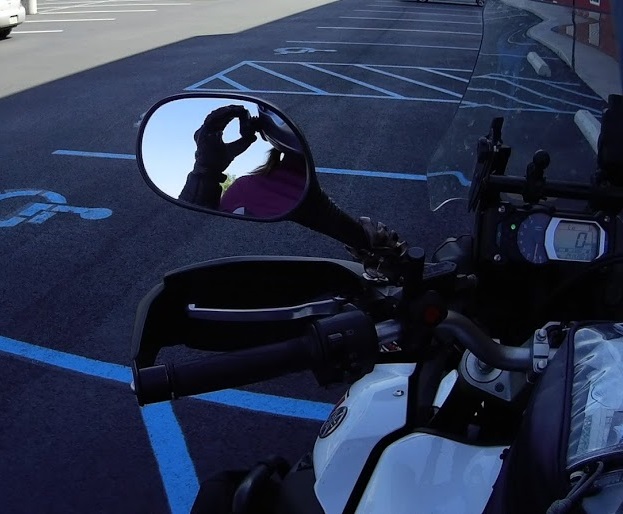
Battery life is surprisingly good for a camera and helmet comm system. If you anticipate only occasional camera use the battery life for communication is an easy all-day affair. If you’re camera and video heavy you can kill the battery inside of four hours. If you’re recording video constantly you’ll kill it in two. There is a good (or annoying) feature, however: the 10C will not let you obliterate its battery with its camera. It will turn the camera off when the battery has only a couple of hours of talk time left, and you will not be able to turn the camera back on until you’ve recharged. But you’ll still be able to talk over your comm for at least an hour.
Once I got used to the functions of the 10C, the GoPro ended up in a drawer, and after months of neglecting it, I gave it to an action-camera-less friend. The Sena’s ease of use made the GoPro seem like only a small step up from my old pink 8mp Nikon Coolpix, and heck, I have a RAM camera mount. Where is that old Nikon anyway…
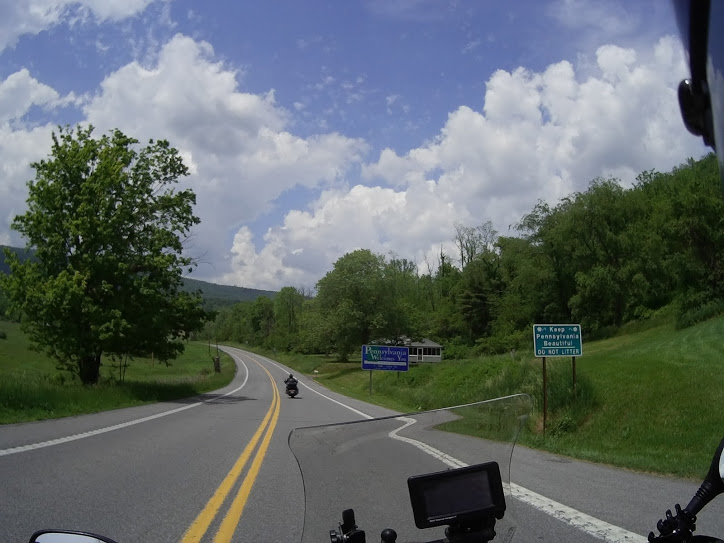
The 10C has a couple of playback/review options: you can use a micro-HDMI cable to plug it into any HDMI-capable TV, or you can pop the microSD card out of it (spring-loaded and tiny! Be careful!) and into anything that’ll read it (I use an LG tablet with a microSD card slot). This means that at the end of the day on a motorcycle tour, I can fire up my tablet and bore everyone with all of the photos and videos I took that day!
The best feature, to my commuter’s mind, is the video tagging: in video tagging mode, the 10C will capture the previous minute, the current minute and the following minute in three one-minute clips. Imagine: set to video tagging mode, the moment you are out of danger, hit that button and save all that preceding mess to video. I don’t need to elaborate; we’ve all been there.
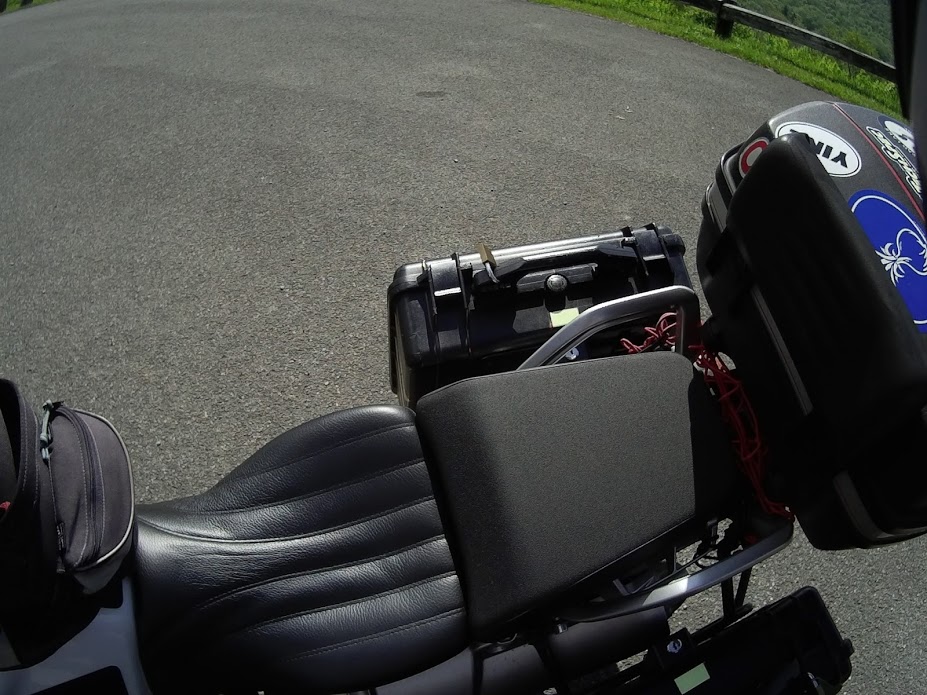
The audio functions can be surprising if you’re like me and start using technology before fully reading and understanding all of the literature. It will record your voice while recording video, so it’s great for all you budding moto vloggers, but it can also record your conversations with other Bluetooth-comm enabled riding buddies, who may or may not want to be recorded. It will also include whatever music you’re piping into your helmet at the time, so keep that in mind if you’re planning to upload to YouTube. Any music that is copyrighted will get your video flagged for takedown. The audio is single-stream and cannot be edited out; choose wisely or go with silence. Also, I found that wind noise will disrupt the soundtrack pretty significantly at highway speeds.
Which brings me to the cons: there aren’t many. This is a spectacular piece of kit. But I wish it had the app depth the 20S does – you can control some features of the 10C with Sena’s smartphone app, but (IMO) the most important one, communicator pairing view & hierarchy control, is missing. Also, while the 10C’s communicator functions can be controlled by the Sena remote, the camera settings and functions are not part of the remote’s protocol. There I go diving into technology again! When I saw the remote was compatible with the 10C I made a bad assumption, hoping to take pictures without having to take my hand off the bar. Alas. It is nice to be able to control the communicator and music functions from the handlebar, though.
I would embed a video here, but there’s no real way to show you just how good the videos are, from this thing. Uploads to the internet suffer compression loss and look like any other crappy youtube video, unless you do your own hosting and can handle the bandwidth (which I don’t).
You can find all of the specs for the 10C at the Sena website (www.sena.com), which states: “It’s capable of full HD video (1080p:30fps and 720p:30/60fps) with 3.5 MP still shot image capture and shot, burst and time-lapse photo modes.” On a large HD TV the video isn’t great. It can tend toward being sort of blocky and streaky. But on a tablet the video is gorgeous. If you’re in the market for a Bluetooth comm system and an action camera, it is hard to go wrong with the 10C.
Buy the Sena 10C from Amazon to Support Us!
]]>My research let me to an LED work light offered by SuperBrightLEDs.com. Though somewhat known for off-road light bars and wacky seizure inducing accent lighting, I’ve purchased LED replacement bulbs for my Subaru BRZ from them before and am quite satisfied with the results. Numerous blogs and forum posts, specifically for my PC800 and otherwise, spoke highly of these lights for motorcycle driving light use. They’re also weatherproof, which is obviously a requirement. So for $34.95 a piece (I saved $5 by ordering red housings to match my bike rather than black or chrome), I ordered two of these lights with a 25° beam angle. They are also available with a 45° beam, but I wanted a narrower beam to shoot the light as far down the road as possible, and to avoid blinding oncoming drivers.
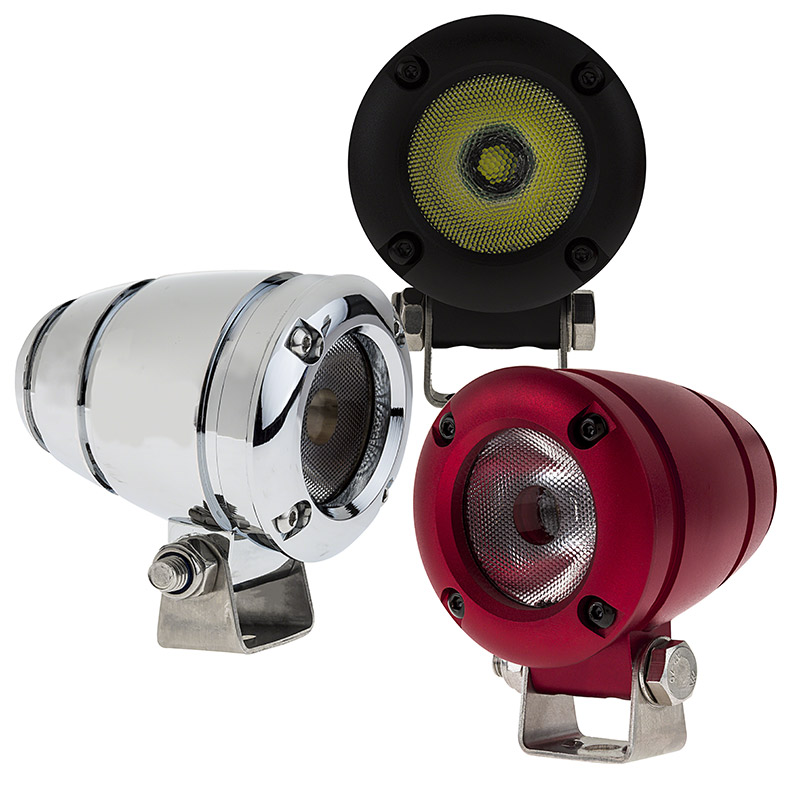
The lights arrived more quickly than expected or promised. I decided to mount them to the front forks in place of the amber reflectors. This would keep the lights down low, as well as enable them to turn with the front wheel, something the stock headlight doesn’t do. The bolts that came with the lights just happened to be the same size and thread pitch to screw in where the reflectors went, but slightly too long, so I bought shorter ones at the hardware store. Physical installation was simple – just bolt on the bracket, then bolt the light on.
You’re on your own for wiring. The lights come with positive and negative pigtails, and that’s it. For testing purposes, I decided to disconnect my halogen driving light and hook the new LED lights to its existing power wiring and switch. Despite there being two lights rather than one, each LED only draws 10 watts, as opposed to 35 from the halogen bulb, cutting my power consumption almost in half. Most bikes, the PC800 included, don’t have much extra electrical capacity, so LEDs are a great option for motorcycle use. Aiming the lights was a little tricky, since I wasn’t able to get a wrench in to loosen or tighten the bolts holding the brackets to the forks with the lights installed, but with some finagling and a couple of failed attempts I got them set the way I wanted.
The difference was literally night…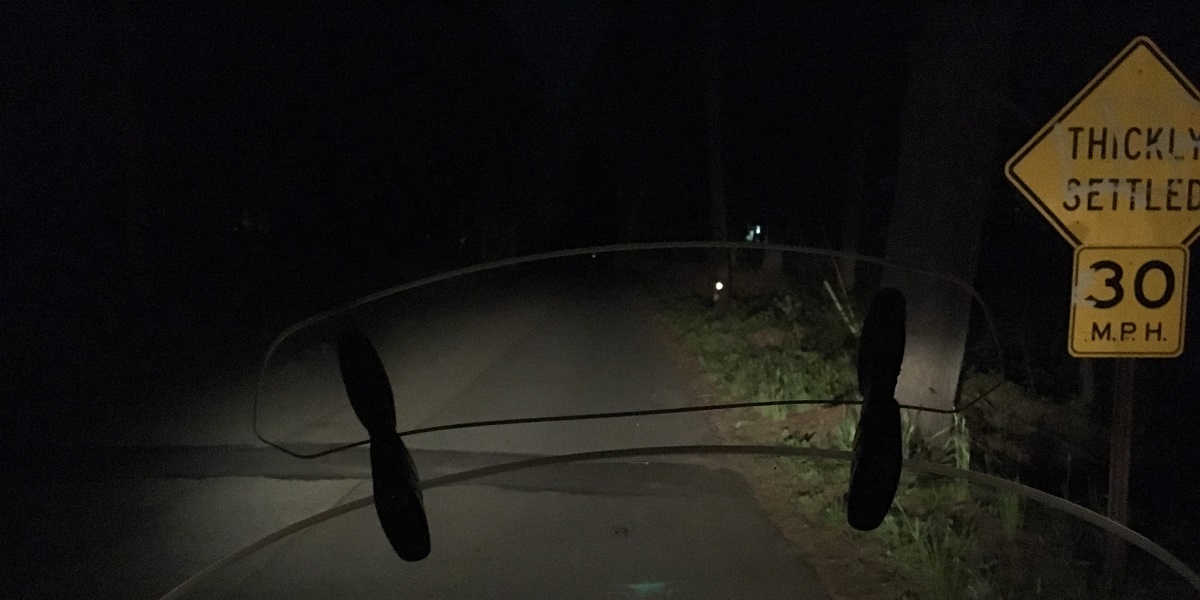
…and day.
My stock headlight is completely overpowered by the twin LEDs on my forks. I can see much farther down the road, and light up reflectors far beyond those that I used to. If I could turn off my headlight I doubt I’d notice much difference in the overall lighting. The LED driving lights are so effective that I decided to remove the old halogen light and wire them into its old wiring permanently.
They’re a great help at night, but the driving lights also significantly improve my daytime visibility as well. Moving the lights farther away from my headlight makes them stand out much better than my old halogen driving light, which blended in with the headlight until you got close. Motorcycles are supposed to have an odd number of lights anyway to differentiate them from cars, which have an even number of lights. The running lights are good, but the driving lights really call out to other traffic “I am a motorcycle” rather than “I am a car with a broken headlight.” Anything to help me be seen and avoid getting cut off is a good thing.
It’s worth mentioning that these lights are not DOT approved, and are sold specifically as work lights, not driving lights. If that presents a problem for state inspection, you might want to turn them off or even remove them before you get checked if you’re worried. In my experience, motorcycles generally seem to get away with brighter lights than cars in the interest of safety. Even if they’re not technically street legal, law enforcement tends to turn a blind eye. I rode right through a speedtrap this morning with these lights a-blazing and had no trouble at all. It probably also helps that I took the effort to mount them low and aim them to be visible, but not blinding, to oncoming drivers.
I no longer have any issues hopping on the interstate at night. While you should always be more cautious after dark, I’m no longer afraid of overdriving my lights at or below the speed limit at night. These are just what I needed for a SaddleSore 1000, as well as for general visibility. And for around $70 for a pair ($80 if you splurge for black or chrome), they are well worth the investment. While more expensive motorcycle specific HID driving lights are probably better than these, I can’t think of a more cost effective option for a good pair of driving lights.
]]>Which is why, until now, ICON has sort of stayed clear from the race helmet thing. Sure, you’d still see some of their lids at the track, but those were mostly on guys who either wanted something they could replace often because they fell over a lot, or guys who were just really obsessed with the looks. And no one came blame them. For $150, the Alliance dark is about as good as it gets.
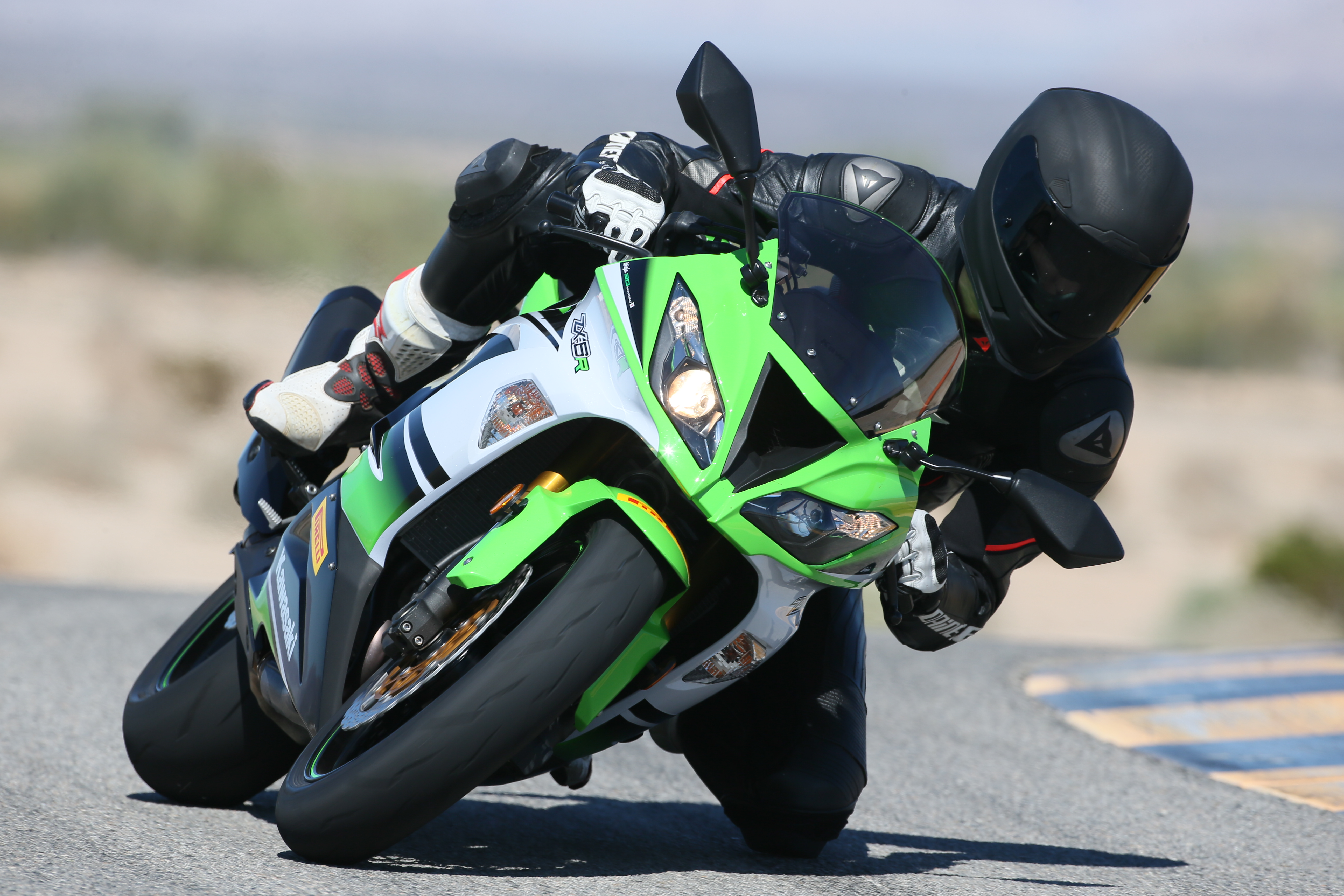
The Airframe Pro, however, is whole new leaf for ICON. Something they spent more time on developing the high speed performance and aerodynamics of rather than the styling. Something that was intended to go fast, and be really good at doing so, rather than just scaring the old lady in the Buick next to you.
The Specs That Matter
The ICON Airframe Pro is a race helmet by nature, despite the fact that I’ve yet to see one on the race track but have seen them all over town. As such, it has a less plush fit and is meant to be worn in more of a tuck – with its eyeport canted slightly up. The bottom rear of the helmet has also been cut out, to help decrease interference when worn in a tuck with a suit/jacket with a speed hump.
The interior liner has been upgraded, from the standard three piece unit ICON normally use to an five piece liner so that the different pieces can be replaced to better customize the fit.
The helmet itself comes in seven sizes, which are created from four different shell sizes.
The Airframe Pro retails for between $375 and $600, depending on which model you get.
We Wore The Damn Thing
I’ve been wearing my ICON Airframe Pro Ghost Carbon for several months now, and can honestly say I’ve put it through just about every test imagineable. The ICON guys were nice enough to get me one two weeks before it came out, so I could wear it while riding the Ducati Monster 1200 R at the press launch at Ascari. Then I wore it at the official launch of the helmet on a Kawasaki 636 at Chuckwalla. Since then, I’ve worn it on everything from supermotos to naked bikes to cruisers, logging hundreds and hundreds of miles from behind it’s dark shield.
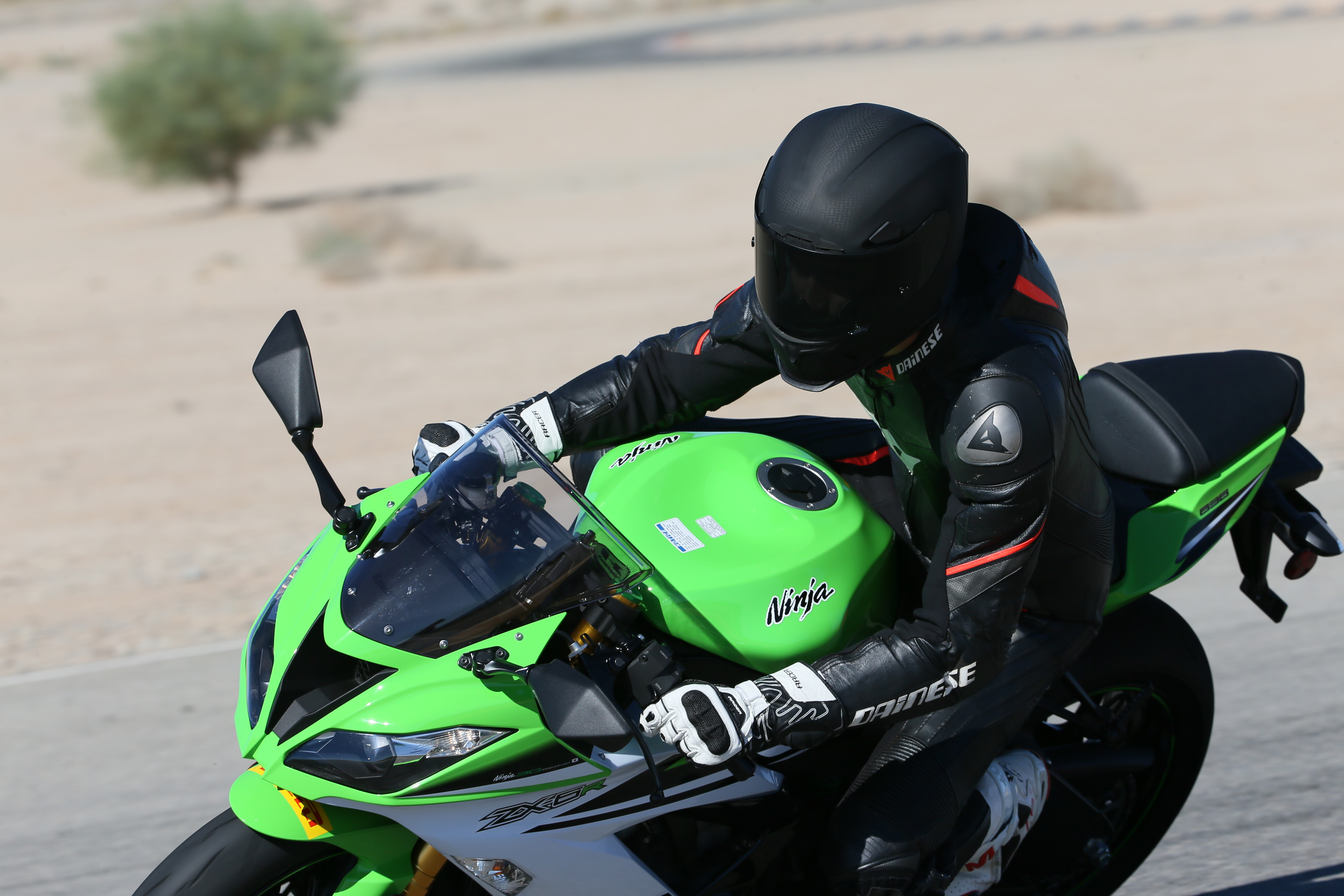
The lady friend loves to wear open face and retro helmets but, fan of her face that I am, I told her she’d be wearing a real full face from now on unless we were shooting photos on bike that required otherwise. Her only request was that it not be covered in “stupid pictures or big logos,” so I picked up an Airframe Pro Construct for her despite her complaints that it still wasn’t as cute as the Biltwell Gringo.
Holding each of the helmets in one hand, you will most likely be able to detect a slight difference in weight. But it’s only just slight and that’s only if you’re actually looking for it. The other main differences come in finish quality, with the gold/brass lettering and clasps really doing it for me (and likely not mattering nearly as much to many of you).
The idea of a “nice” ICON was really interesting to me, and I was quite curious as I opened the box. The interior of ICON’s helmets have always felt like a neoprene material that, while not us plush as the inside of an Arai, is something I’ve always been fond of. I was pleased that the AFP, in fit and finish, felt still very much like an ICON helmet – just one turned up to eleven.
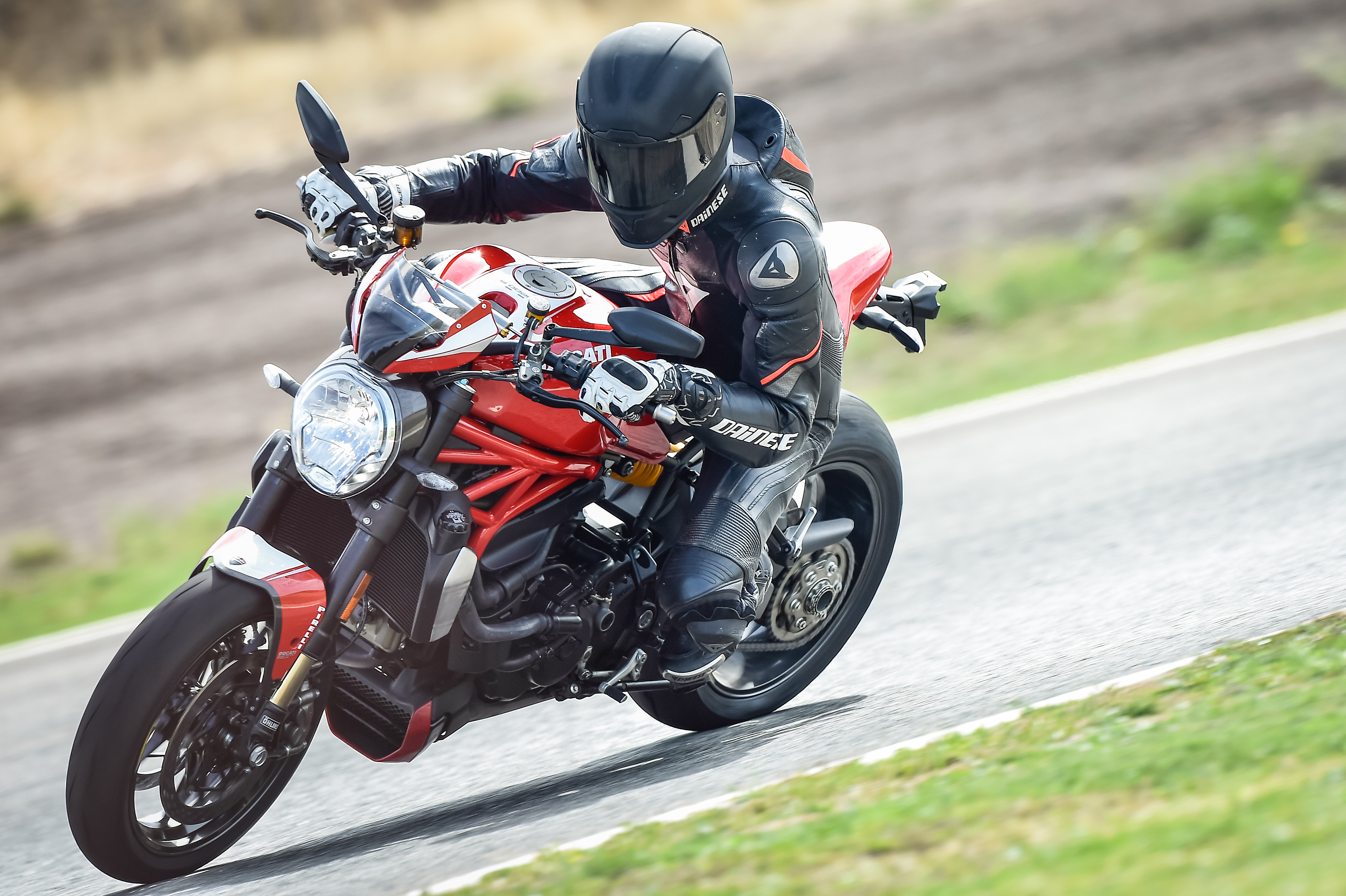
The visor mechanism is still a finger bruiser, but the shield locking tab, helmet strap d-rings, interior, and finish are all better than I could have imagined. They’re subtle in a way no helmet, but especially an ICON, has ever been. The overall shape still has an attitude to it, but it isn’t obvious until you pick the thing up just how pretty it is.
On, the helmet is snug, but not as soft as other of their helmets. This makes a day on a cruiser like the Harley Low Rider S not quite as comfortable, but also keeps the helmet in place when you’re hanging it out on the track. Like a KTM seat, it’s firm in a way you notice when you put it on, but then it leaves your attention until you’re surprised that it’s firmness feels nice instead of painful.
ICON claim the helmet was designed to be worn in an “attack” position, meaning with your head tilted down like you would be when riding a sport bike aggressively or tucked. Based on my testing this is accurate, but only in the ways it deals with wind at over 100 miles per hour.
When riding nakeds or bikes that sit more upright at high speeds, it does buffet a bit and let in a little too much wind from the opening, but only once you get moving at track (or track-like) speeds.
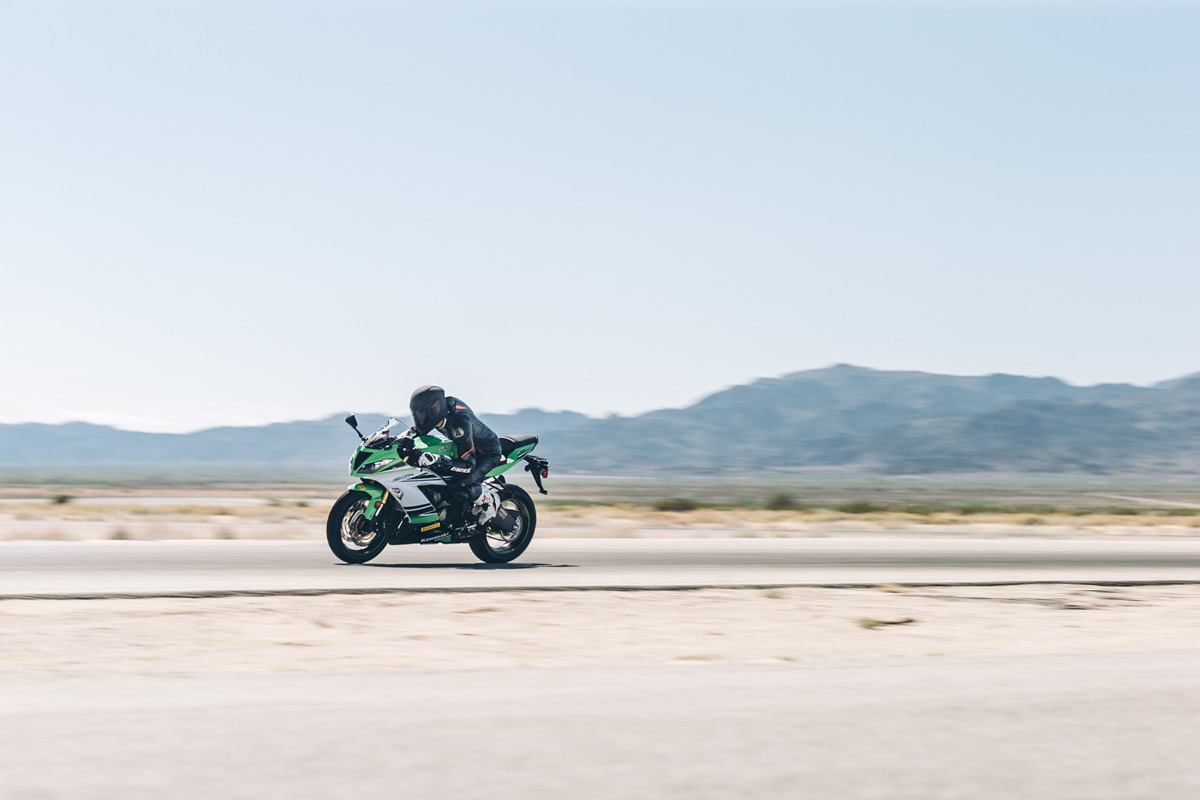
Venting is also excellent, with cool air blowing directly to the face and forehead thanks to the TKTK vents, which can also be closed and do a relatively decent job at keeping all the wind out.
Things We’d Change
The only real issue I had with the helmet was with the little chin curtain accessory that came with it. It was not stretched tight enough across the bottom of the helmet and would flap in the wind against the underside of my jaw and neck when riding at high speeds.
It also kept pulling out when I took the helmet off. By the time I was headed to Chuckwalla, just weeks after the helmet was delivered, the tabs that held it in place started to separate and I ditched the curtain altogether (which explains the excessive wind when riding more upright bikes).
Why You Should Care
There are sport helmets I like more than the ICON Airframe Pro for track riding. The Schuberth SR1 is still my favorite helmet on the planet, and the new Shoei X-14 is simply stunning looking and wonderful on the track. But. Those helmets will also cost you an actual arm and a leg.
At $450, the ICON Airframe Pro is as good as it gets for those of you serious about riding in something nice on the track without breaking the bank. It will be better at speed that similarly priced Shoei or Bell helmets, and not break in nearly as much which means it won’t move around at speed over time.
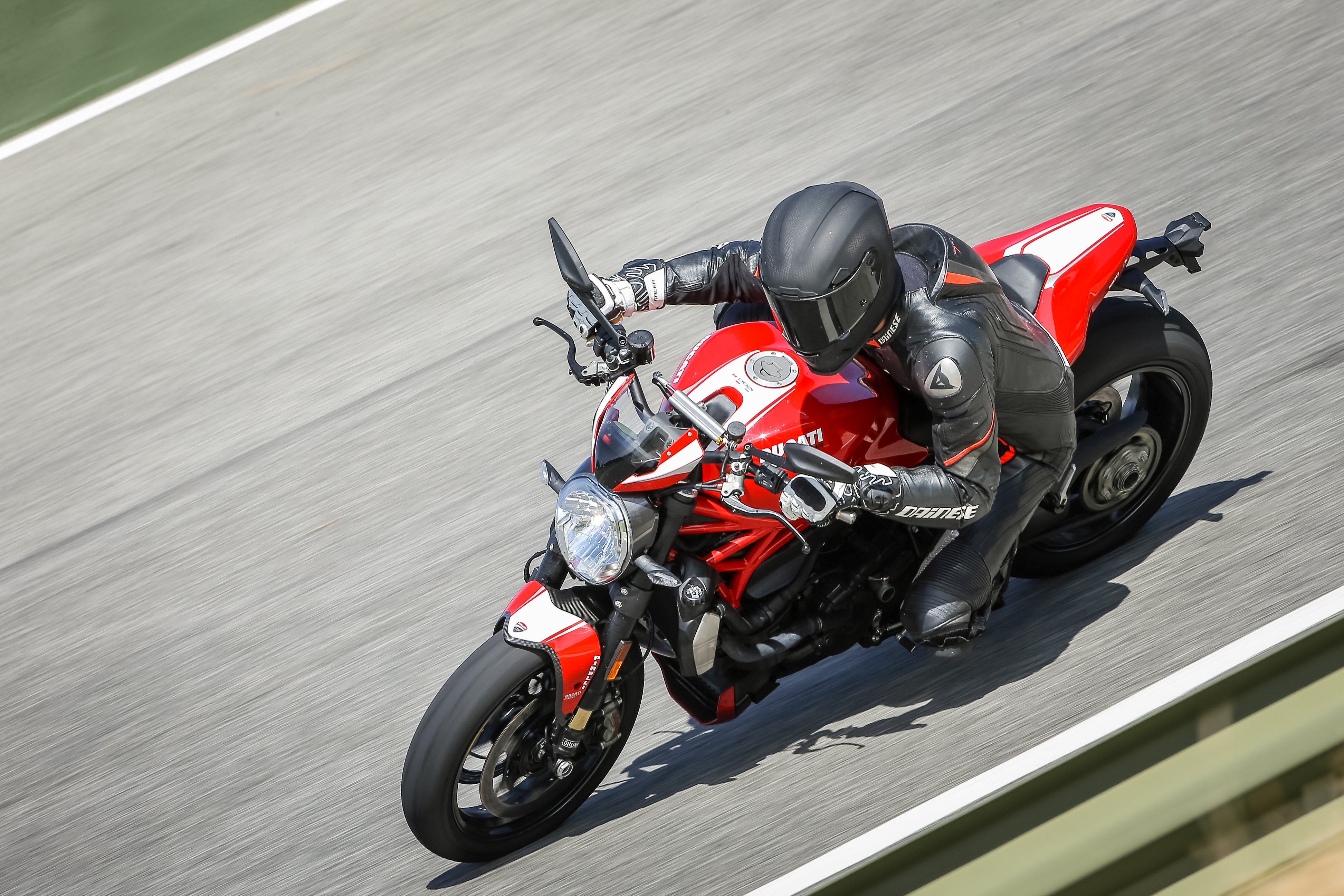
Or, if you can spare the extra coin, you can get a truly beautiful helmet that’s still cheaper than many of the other options and that you’ll love every time you put it on.
]]>After some research I ended up buying a Puig clip-on windshield extension from Revzilla. It’s super simple, and at first doesn’t look worth its $108.85 sale price for a piece of clear plastic and two small brackets. But as I assembled and installed it, I could see that the money goes into a well thought out design and high quality parts. There’s no drilling involved, and single Allen wrench is all you need. Naturally I lost all of mine in the move to my new house, so I took a quick trip to buy a replacement after tearing the place apart looking for them.
Replacing my wrench set was the most time consuming part of the installation. Two bolts attach each bracket to the visor, and a single bolt loosens and tightens the clamp onto the top of the existing windshield. The clamp is extremely well padded where it clamps down, and shouldn’t hurt the windshield at all.
 I never understood why fancy bikes have power windshields that you can raise and lower – until now. All the way down, it still sits just tall enough to greatly reduce the noise in my helmet. I can leave my helmet visor open for fresh air but still be protected from the direct wind blast, bugs, rocks, alien spacecraft, etc. Raise it all the way up, and it blocks everything – great for cold mornings, fast highways, and especially cold mornings on fast highways. I have to look through the extension rather than over it, which I don’t prefer, but that’s the price of total coverage, and sometimes it’s worth it.
I never understood why fancy bikes have power windshields that you can raise and lower – until now. All the way down, it still sits just tall enough to greatly reduce the noise in my helmet. I can leave my helmet visor open for fresh air but still be protected from the direct wind blast, bugs, rocks, alien spacecraft, etc. Raise it all the way up, and it blocks everything – great for cold mornings, fast highways, and especially cold mornings on fast highways. I have to look through the extension rather than over it, which I don’t prefer, but that’s the price of total coverage, and sometimes it’s worth it.
While not operated by motors and switches, it’s easy to adjust up and down, even while in motion. The notches in the hinges’ movement are stiff enough to not vibrate, even on rough roads or at high speeds. It hasn’t been warm enough yet for me to do this, but it’s even possible to angle the extension to deflect air toward me instead of away if I want to cool off. It’s far more effective than the vent built into the ClearView windshield.
Arguably the right way to fix the problem is to replace my windshield with a taller one, sized specifically for me. It would also be far more expensive, more work, and it wouldn’t provide ventilation when I want it like the extension does. It may not look as sleek as a single piece windshield, but I don’t care. It’s effective, and between its added protection from the elements as well as allowing them in when I want to, it’ll actually extend my riding season. It seems like a lot of money for a piece of clear plastic and two brackets, but I think it’s well worth it for the advantages it provides.
]]>In 1989, Honda introduced the Pacific Coast 800 – a motorcycle for people who don’t ride motorcycles. It’s said that while Honda’s motorcycle engineers laid the groundwork, they gave their automotive engineers the task of putting it all in a friendly package that would appeal to the average Civic or Accord driver, rather than someone cruising along on a VT1100C Shadow or dragging a knee on a CBR1000F. This commercial from 1988 shows that the PC800 wasn’t exactly aimed toward Harley riders.
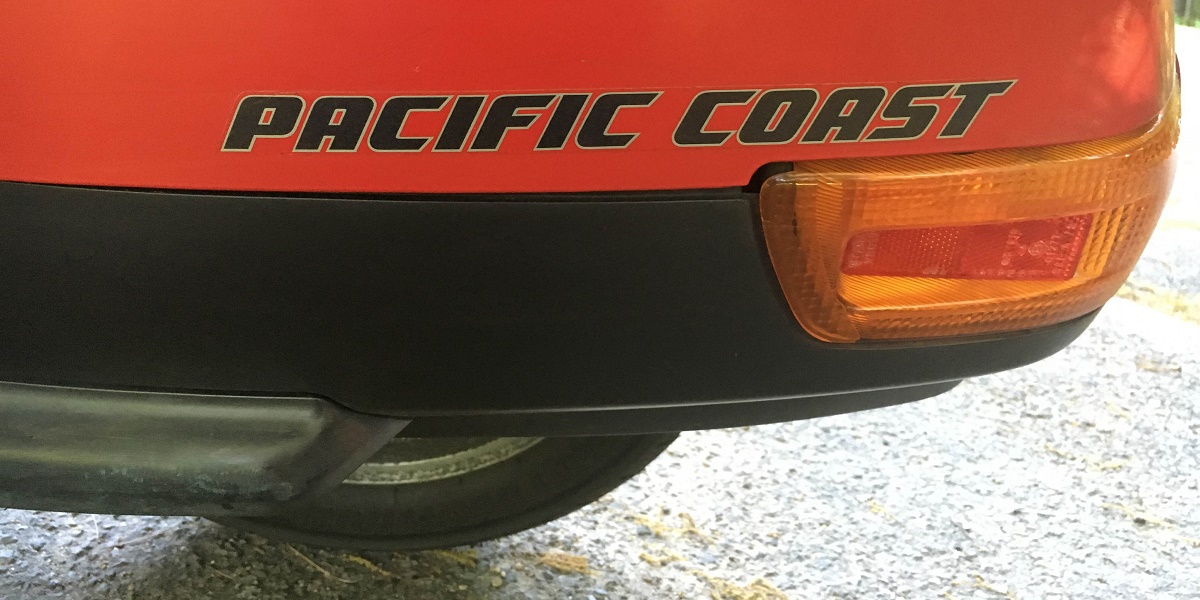 These days it’s quite common to see crotch rockets or sport touring bikes completely covered in plastic, hiding the innards to achieve better aerodynamics. But in 1989, such use of plastic on a motorcycle was quite rare. American style cruisers and the ubiquitous UJMs hung their inner workings out in the open for all to see. The type of driver-turned-rider that Honda was targeting with the PC800 couldn’t care less about shiny chrome valve covers, so they covered it all up. It looked downright futuristic by contemporary standards, which lead to the PC800 appearing briefly in Back to the Future 2 as literally a bike from the future.
These days it’s quite common to see crotch rockets or sport touring bikes completely covered in plastic, hiding the innards to achieve better aerodynamics. But in 1989, such use of plastic on a motorcycle was quite rare. American style cruisers and the ubiquitous UJMs hung their inner workings out in the open for all to see. The type of driver-turned-rider that Honda was targeting with the PC800 couldn’t care less about shiny chrome valve covers, so they covered it all up. It looked downright futuristic by contemporary standards, which lead to the PC800 appearing briefly in Back to the Future 2 as literally a bike from the future.
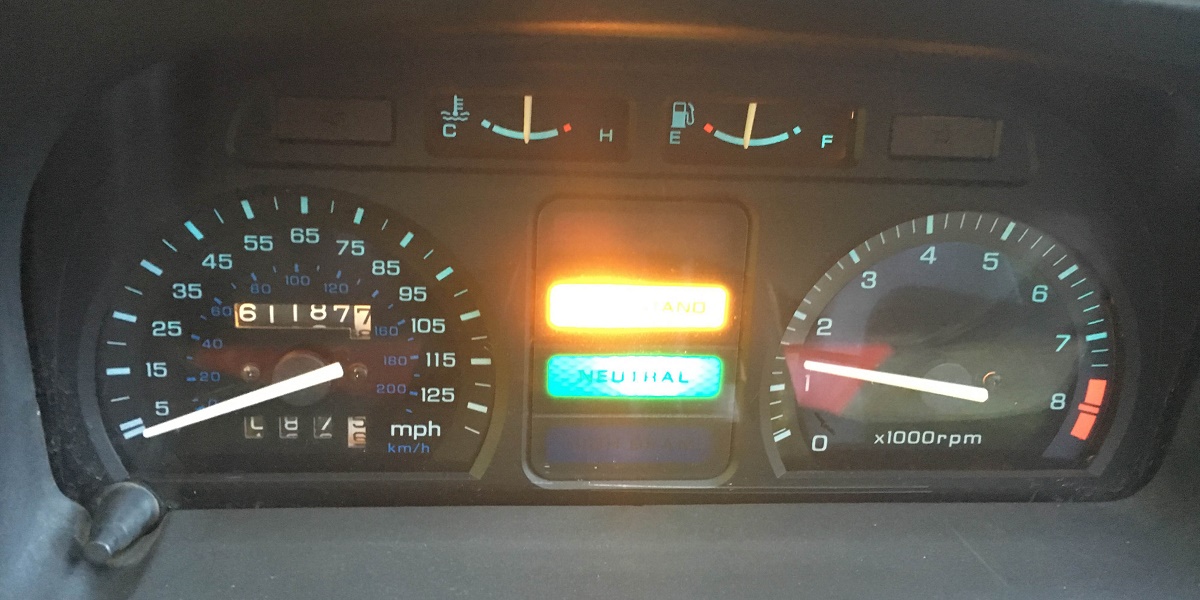 The seat is only 30″ tall, making the PC800 accessible to a wide variety of shapes and sizes of riders. The plastic covering continues here, too, as even the handlebars are covered in it. The gauge cluster looks like it came straight out of a 1989 Civic. The speedometer and tach have swapped sides, the fuel and temperature gauges have rotated a bit, and the car-specific warning lights have been replaced with neutral and kickstand indicators, but any EF Civic driver will feel right at home here.
The seat is only 30″ tall, making the PC800 accessible to a wide variety of shapes and sizes of riders. The plastic covering continues here, too, as even the handlebars are covered in it. The gauge cluster looks like it came straight out of a 1989 Civic. The speedometer and tach have swapped sides, the fuel and temperature gauges have rotated a bit, and the car-specific warning lights have been replaced with neutral and kickstand indicators, but any EF Civic driver will feel right at home here.
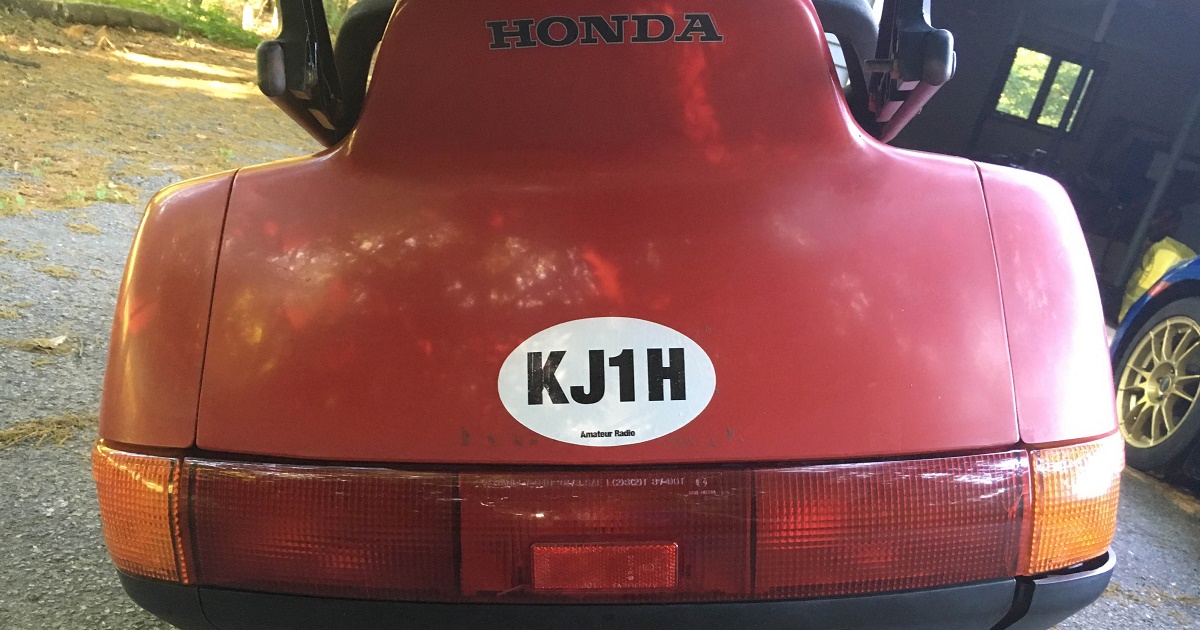 Step around to the back, and the wide wraparound tail light strip bears a striking resemblance to that of the 1989 Accord. Though three bulbs illuminate the whole thing, only the outer two serve as brake lights – again, like a car.
Step around to the back, and the wide wraparound tail light strip bears a striking resemblance to that of the 1989 Accord. Though three bulbs illuminate the whole thing, only the outer two serve as brake lights – again, like a car.
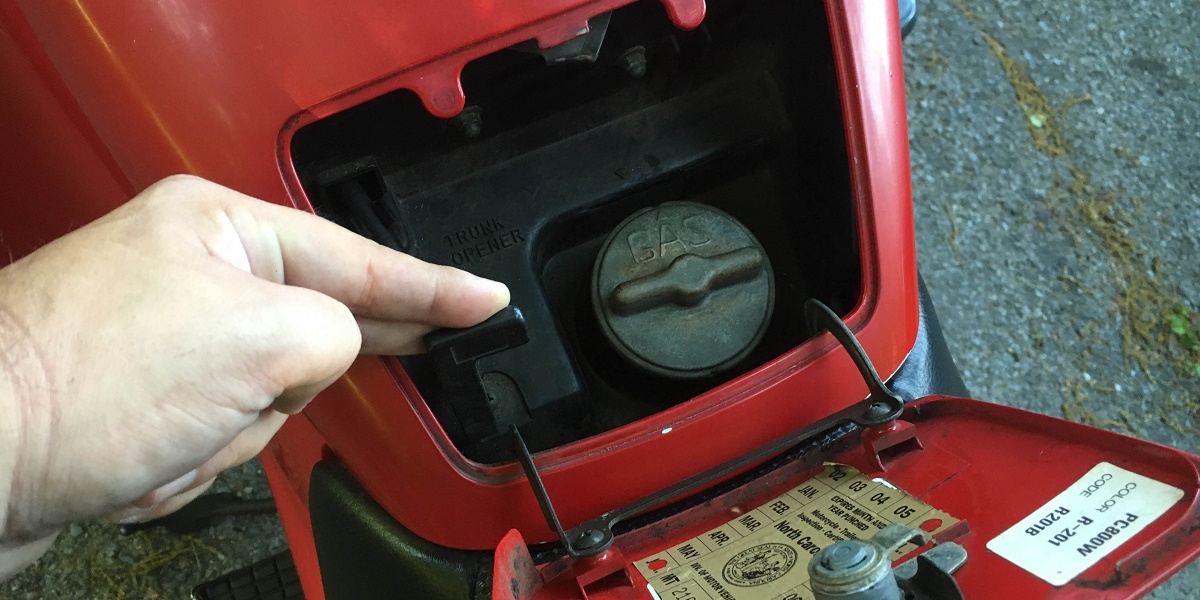 But the coup de grâce is the trunk. The PC800 has an unusually wide butt. When you unlock the gas cap on the “fuel tank” (which is fake – the actual tank is below the seat to keep the weight down low) and pull on a trunk release lever (which, again, looks like it was recycled from a Civic or Accord)…
But the coup de grâce is the trunk. The PC800 has an unusually wide butt. When you unlock the gas cap on the “fuel tank” (which is fake – the actual tank is below the seat to keep the weight down low) and pull on a trunk release lever (which, again, looks like it was recycled from a Civic or Accord)…
 …the entire top rear of the bike, including the passenger seat, hinges forward just like a car’s trunk lid, revealing two large storage compartments on either side of the rear wheel. These replace traditional saddlebags, and can carry a great deal of cargo. They’re also waterproof thanks to a large overhang from the trunk lid. A previous owner added a Givi top trunk to my bike’s already generous cargo capacity, allowing me to carry everything I needed for a week long tour of New Brunswick and Nova Scotia to ride the Cabot Trail a few years ago. Time, rather than space, prevented me from touring even farther than that.
…the entire top rear of the bike, including the passenger seat, hinges forward just like a car’s trunk lid, revealing two large storage compartments on either side of the rear wheel. These replace traditional saddlebags, and can carry a great deal of cargo. They’re also waterproof thanks to a large overhang from the trunk lid. A previous owner added a Givi top trunk to my bike’s already generous cargo capacity, allowing me to carry everything I needed for a week long tour of New Brunswick and Nova Scotia to ride the Cabot Trail a few years ago. Time, rather than space, prevented me from touring even farther than that.
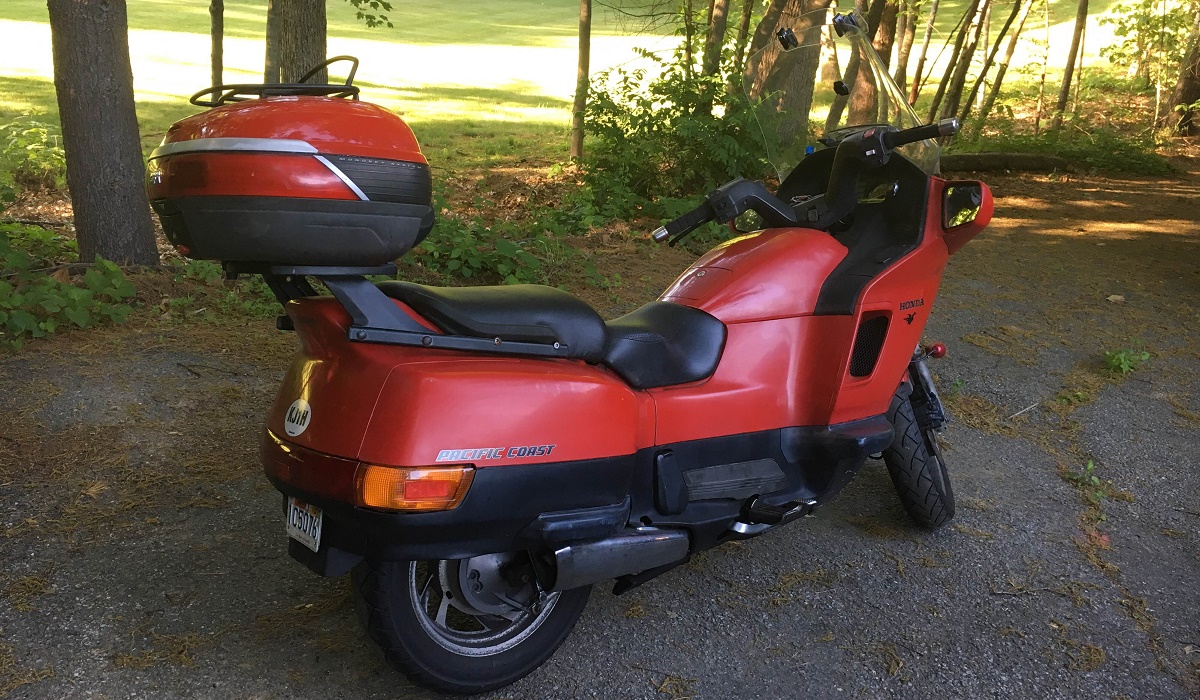 So what’s it like to ride? The PC800 is a unique design that falls most closely into the sport touring segment. But its 800cc motor, sourced from the Shadow VT800, is significantly smaller than the Honda ST1300, BMW R1200RT, and Yamaha FJR1300 that are so popular in this segment. I’m not a particularly fast rider, and while I’ll sometimes use all the power the PC800 can give me up a steep hill or when merging onto a busy highway, I don’t find it lacking at all either. It’s about as smooth as a Harley is not, which is pretty amazing considering that both motors are V-twins. It’s also rather quiet. When you’re in the saddle the bike sounds more like George Jetson’s flying car than a V-twin. Handling is rather good, since most of its roughly 600lbs sits down low in the frame, partly thanks to that low riding gas tank. It’s no sport bike but it’s fairly responsive through the corners. When it’s time to stop, dual discs in front and a drum in back do the job well.
So what’s it like to ride? The PC800 is a unique design that falls most closely into the sport touring segment. But its 800cc motor, sourced from the Shadow VT800, is significantly smaller than the Honda ST1300, BMW R1200RT, and Yamaha FJR1300 that are so popular in this segment. I’m not a particularly fast rider, and while I’ll sometimes use all the power the PC800 can give me up a steep hill or when merging onto a busy highway, I don’t find it lacking at all either. It’s about as smooth as a Harley is not, which is pretty amazing considering that both motors are V-twins. It’s also rather quiet. When you’re in the saddle the bike sounds more like George Jetson’s flying car than a V-twin. Handling is rather good, since most of its roughly 600lbs sits down low in the frame, partly thanks to that low riding gas tank. It’s no sport bike but it’s fairly responsive through the corners. When it’s time to stop, dual discs in front and a drum in back do the job well.
Something you won’t have to do much with the PC800 is maintenance. Many riders enjoy tinkering with their bikes, adjusting and improving them to their own particular specifications. Given the PC800’s intended audience of non-bikers, it has hydraulic valve adjusters, automatic cam chain tensioners, a hydraulic clutch that never needs adjusting, and an electronic ignition. Some of these features aren’t even standard equipment in 2016, never mind in 1989 when the bike was introduced. Shaft drive avoids the tedium of adjusting a chain or belt. And although it relies on a pair of carburetors rather than modern fuel injection, I’ve never had any problem starting it no matter what the temperature.

If I had to compare the PC800 to a modern car, I’d say it’s probably much like a Mazda CX-5. It’s practical, comfortable, easy to ride, and has a good deal of storage space. But when you push it a little, it’s also surprisingly fun – something you don’t necessarily expect given its roots. Perhaps Honda’s motorcycle engineers got the last laugh. Though marketed toward non-riders, the PC800 is packed with enough fun that it might have converted some casual commuters into serious bikers.
]]>